
The James Beard Foundation’s annual awards — considered the “Oscars of the food world” — named its Outstanding Restaurant for 2019, and it’s not in foodie meccas New York City or Los Angeles.
Zahav, which serves modern Israeli cuisine, is in Philadelphia.
“I remember thinking how during the first few months we were open, we thought there was no way we were going to make it to our anniversary,” Zahav co-owner Steve Cook tells CNBC Make Itof the restaurant, which celebrated its 11th anniversary on Sunday, the day before the award was announced.
(This story was originally published by Jimmy for CNBC. See it here).

“To go from nearly rock bottom to the absolute pinnacle is almost unbelievable.”
The restaurant is helmed by chef Michael Solomonov, who was nominated for the Outstanding Chef category in 2016.
One of the signature dishes at Zahav (which means “gold” in Hebrew, according to Cook), is the whole-roasted lamb shoulder with pomegranate and chickpeas.
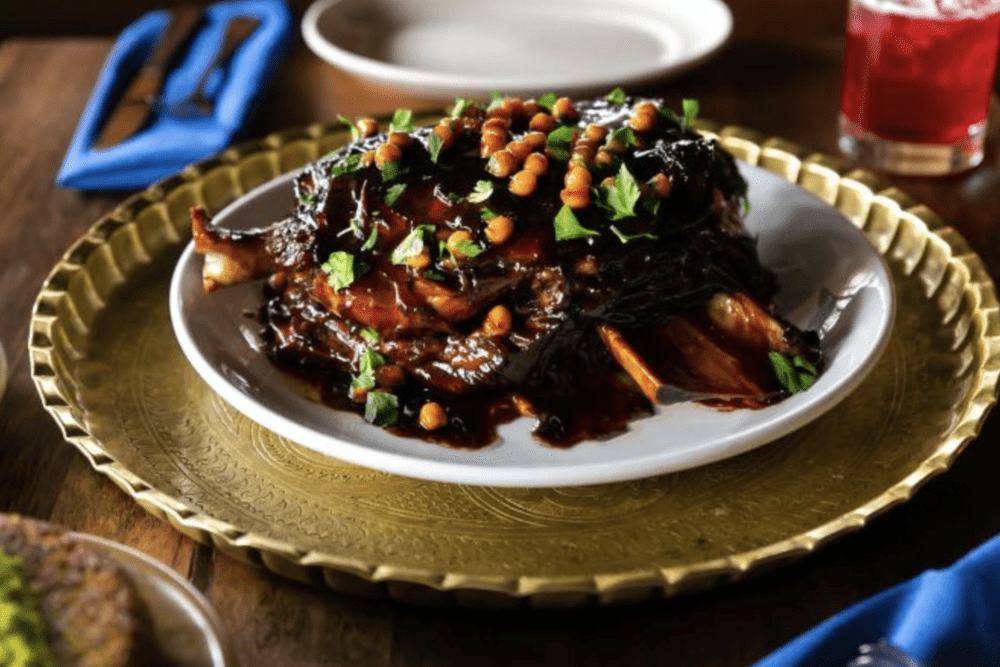
The restaurant also does a tasting that is a “tour of the whole menu,” according to Cook.
Popular tasting menu “Tayim,” for example, includes salatim (small vegetable salads and slaws), hummus with laffa (Middle Eastern bread), two mezze (small plates), one al ha’esh (a grilled offering) and dessert for $48 per person.
Other popular dishes include cherry tomatoes with anchovy dill tabbouleh, beef-heart shawarma and chicken liver pastilla with fig, tehina and Fresno chile.
For the James Beard award, Zahav beat out French restaurant Balthazar in Manhattan; Southern restaurant Fig in Charleston, South Carolina; Spanish restaurant Jaleo in Washington D.C.; and contemporary Californian restaurant Quince in San Francisco.
The Best New Restaurant award went to French bistro Frenchette in Manhattan, and Ashley Christensen of Poole’s Diner in Raleigh, North Carolina was named Outstanding Chef.
The James Beard Foundation has been giving top honors in the food and beverage industry since 1990. A win, or even nomination, can increase buzz for a business, according to CNN. So Zahav — which is already a notable restaurant in Philly, according to Cook — may be about to get even more popular.
“It’s a good problem to have,” says Cook.
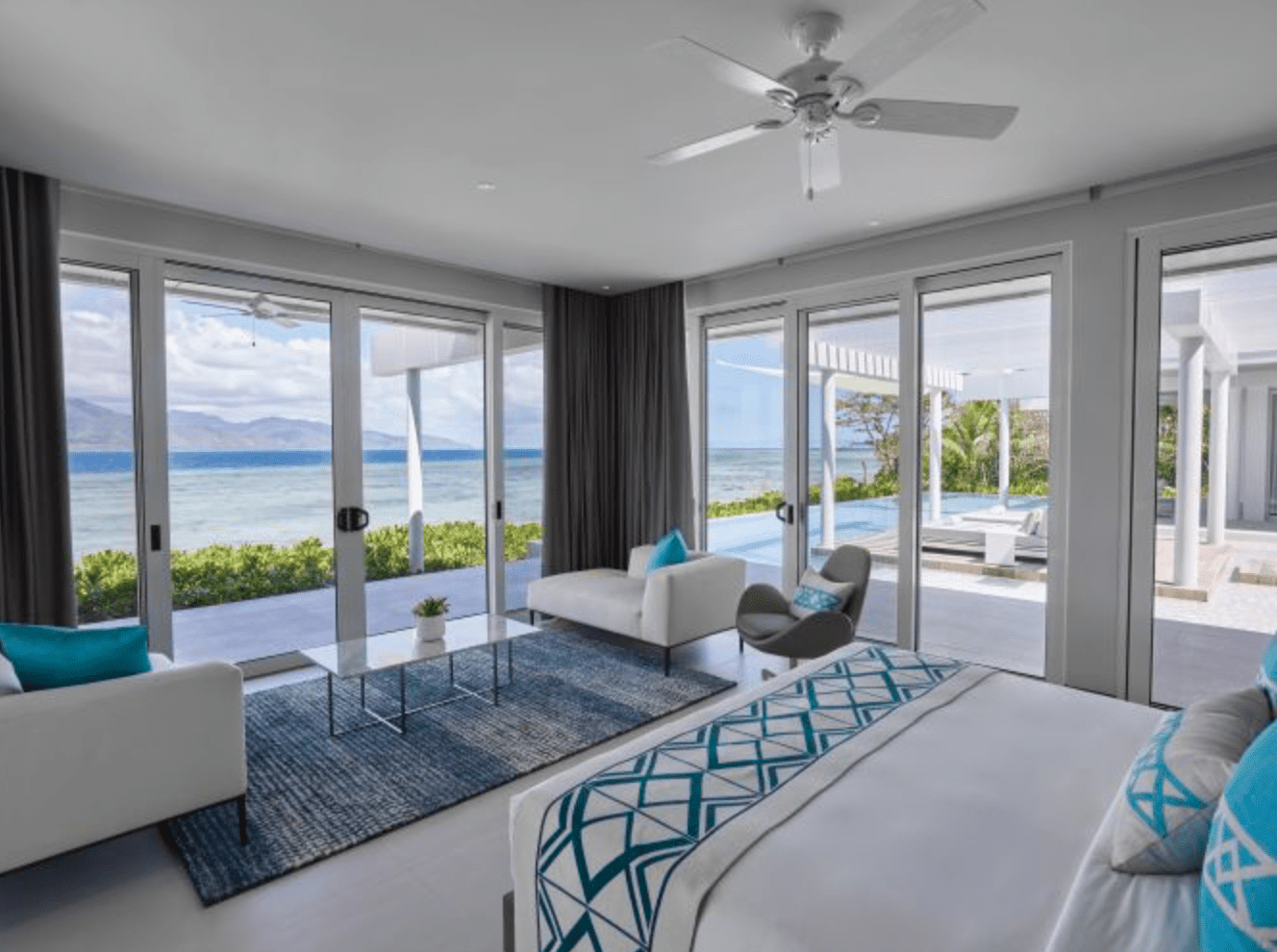
Musha Cay in the Bahamas, owned by David Copperfield, costs $42,000 a night. Necker Island, Richard Branson’s private island resort in the British Virgin Islands, will set you back $77,500 a night.
But Banwa Private Island, a new resort in the Philippines, costs $100,000 a night — the most expensive island resort in the world.
So, what do you get for a six-figure stay? See below.
(This story was originally published on CNBC.com… check out the rest of my stories for CNBC MAKE IT here).

Banwa Resort & Spa.
The 15-acre island resort located in the archipelago of Palawan is a two-hour helicopter or seaplane ride from Manila.
On the secluded island, there are six beachfront villas (ranging from one to four bedrooms) all with a private infinity pool and Jacuzzi. There are also 12 garden rooms and a top-level residential suite. The island can accommodate up to 48 people.

The inclusive resort has a full staff of chefs who cook with vegetables from the onsite organic farm and fish caught from the surrounding Sulu Sea. The resort even makes its own honey. The wine list has bottles costing as much as $36,000 (though premium wines are not included in the resort rate).
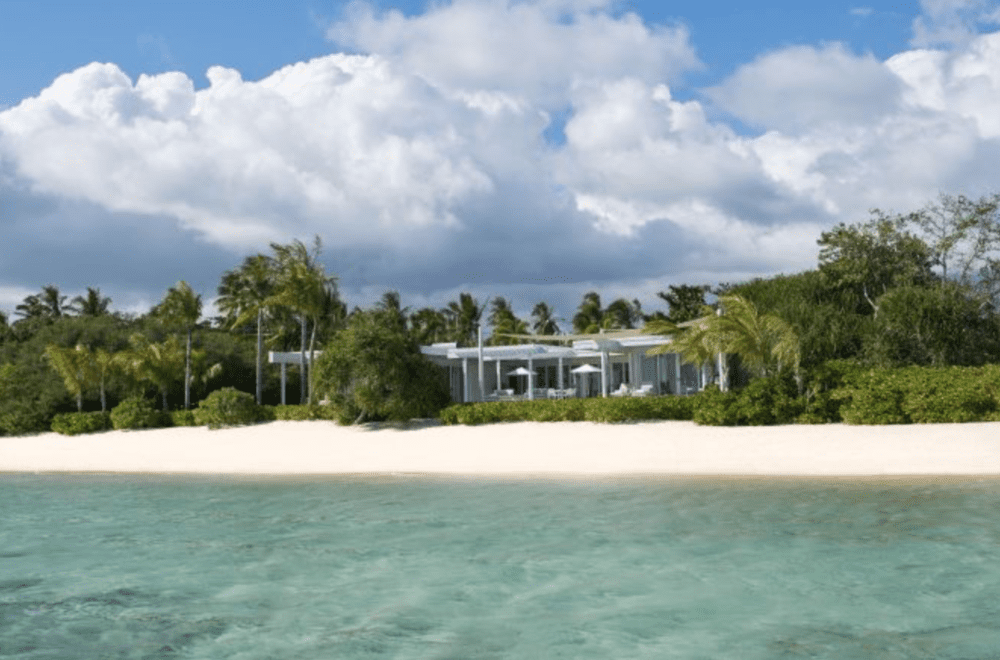
Guests have use of an island concierge and they can get unlimited spa treatments.
Banwa also has a myriad of included activities, like snorkeling, kayaking, jet skiing, scuba diving, sailing, yoga and tennis. There is an on-site marine specialist to talk about the local wildlife, including protected native animals like Hawksbill sea turtles and Tabon birds.
Transfers to and from Manila are not included, and prices start at $990 per way for a nine-passenger seaplane and $11,580 round-trip for a five-passenger helicopter, according to Banwa. Minimum stay requirements range from three to five nights depending on the time of year.
Giving Banwa a run for its money is the most expensive hotel room in America, the new Damien-Hirst-designed Empathy Suite at Palms Casino Resort in Las Vegas. The room costs $100,000 a night with a two-night minimum stay.
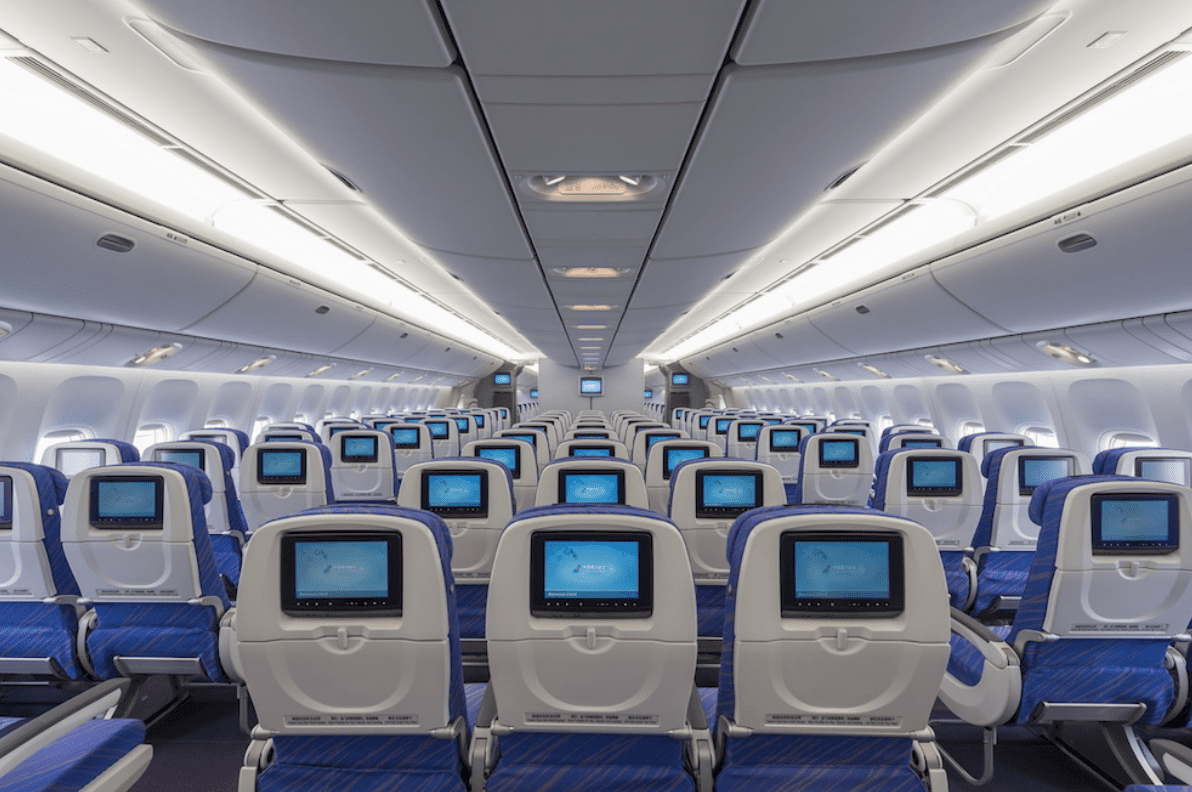
If economy class was actually great, we wouldn’t dread flying. What else would explain most outbursts, fights and unruly passengers getting kicked off planes in the back of the plane? Coach sucks. Seats are tiny (and notoriously getting smaller), passengers are fighting over armrests, there’s two bathrooms for 200 + passengers and service is impersonal and average. All things considered, flying coach raises stress levels, minimizes comfort and gives passengers no option but to stick it out rather than enjoy the flight. Even flight attendants hate working in coach (befriend a stewardess and you’ll find out this is not a myth.).
While 99 percent of coach is not fun, there’s that 1 percent of airlines that actually get praised for top-notch economy classes. If I do fly coach, I don’t cry about being booked on these six airlines. You receive better-that-average seats, flight crew who give a F, notable innovations, better food and more amenities. Whenever you’re booking flights, especially long haul, make sure these airlines are a priority as you actually might sit back, relax and enjoy the flight.
6 airlines with economy classes that do not suck!
1. Singapore Air. Consistently ranked one of the top five airlines in the world (and the best airline in Asia), Singapore Air totally pampers passengers in first and business class, and some people consider flying Singapore an experience it itself. In fact, coach class feels premium with great food, spacious seats, amenity kits and award-winning service. Singapore regularly invests hundreds of millions of dollars to stay relevant and up to date with their planes, and it recently unveiled a HUUUGGEEEE upgrade to its A380, which is basically the standard plane used for most of its flights.
What you can expect in coach:
-Seats offer spacious legroom and back support (32-inch seat pitch and 18.5″ seat width), with a six-way adjustable headrest with foldable wings. There’s also 6 inches seat recline, and ergonomically designed footrest with adjustable positions. This is definitely more than you can expect from most major airlines.
-11.1-inch touch-screen, seat-back monitor with award-winning entertainment with more than 1,000 options to choose from.
-Reading light installed underneath setback screen, a coat hook, in-seat power supply.

Singapore economy class.
2. Emirates. Emirates has an actual bar on board, a mini-bar at every seat and showers in business and first (#goals), so you know they’re also giving coach passengers something to talk about. Emirates (out of UAE) operates flights on 777s and A380s, the best in the biz, and they have great marketing, so you see them EVERYWHERE (Jennifer Aniston, anyone?). One thing to keep in mind: Emirates hasn’t released new innovations to their coach seats in some years while their competition (like Singapore) has been ahead of the game. Better keep apace, Emirates! Even still, great coach class that outranks most major airlines.
What you can expect:
-Tons of option for food, and even pizza for snacks.
-Amenity kit with toothbrush, socks, eye mask.
-Seat width ranges from 17.5 (777) to 18.5″ (A380), which is quite small. This is possibly the worst drawback (for scale, Spirit Airlines “Big Front Seats” are 18.5″ and you know that’s not big.). The compromise is that Emirates coach class seats recline more than the average seat, which helps you sleep better on long-haul flights, and seat pitch is better.
-Nice touches like hot towels (generally only business and first receive this) and WIFI.
-Most A380 seats have huge 12.1″ personal screens. This is huge, bigger than some laptops.

Emirates economy class about A380.
3. American Airlines. This is not a joke. American Airlines, a US-based airline, notoriously low ranked among airlines in the world, is on this list, and you can thank the 777-300ER for that. The fleet of new jets that debuted about five years ago are top of the line, and you can actually fly them domestically. This is among the best, most innovative planes you can fly in our country (on longer routes like LA to NYC or LA to Miami), and it’s the same plane that would go long distance, like LA to Hong Kong. It’s only great if you’re flying in the states. I would not recommend flying coach on this plane on international flights unless you absolutely have to but do know it is better than, say, United.
What you can expect:
-Seatback entertainment on big screens (and NO EDITED CONTENT! A lot of airlines edit content, which is a huge bummer… why would you play a movie like Snatched when you edit out the best parts? American Airlines thankfully does not do this).
-The 17” seat width is not great but its better than most other US-based coach class seats.
-There are only 202 coach seats. This is great because other airlines pack passengers in like sardines with 300-400 seats for international flights. So this is basically half the load on American.
-USB and power outlet at every seat.
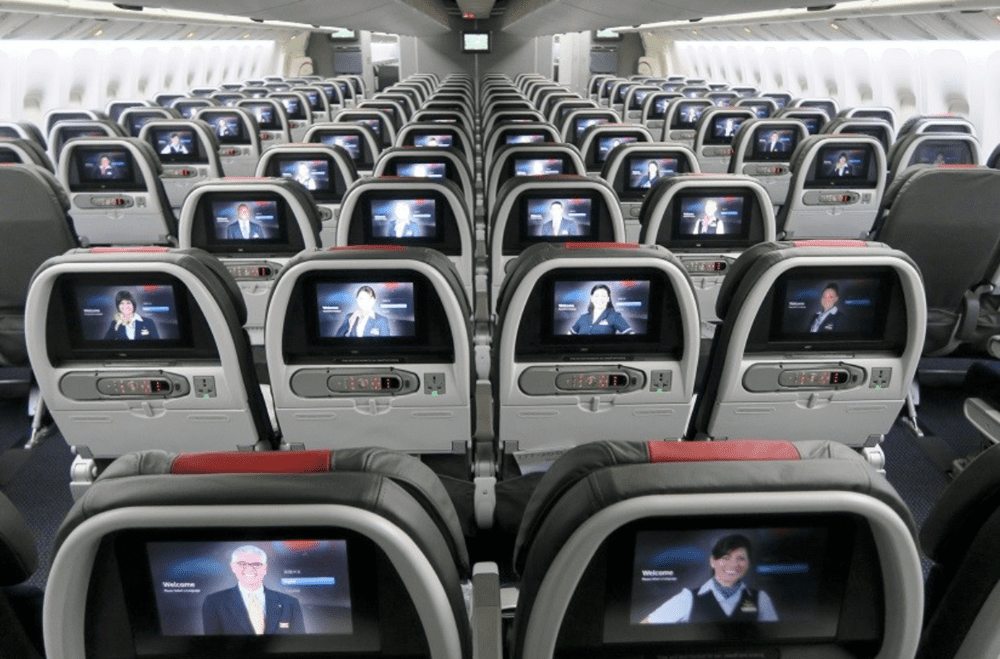
American Airlines economy seat aboard 777-300ER.
4. Garuda. Here’s the airline always ranked in the Top Ten Airlines in the World but you’ve never heard of. In fact, you’re never going to fly Garuda unless you travel to Asia (more specifically, Indonesia, where the airline is based). The airline is actually quite awesome and surprising. I’ve flown Garuda a few times and my expectations were exceeded, especially recently with their huge fleet renewal. The planes are clean and modern, the staff is some of the friendliest in the sky, you get meals even on flights as little as an hour and there is seatback entertainment for shorter flights! Garuda is actually well known for its great economy class, consistently winning awards. Just Google any flight review and you’ll see critics LOVE Garuda (yes, even in economy!)
What you can expect:
-Southeast Asian cuisine that is actually quite good.
-Really amazing, personalized service. The flight attendants will win your hearts. They actually make flying tolerable. In most Asia/Southeast Asian countries, getting a job as a flight attendant is not easy, so flight attendants are like celebrities (think about the amount of candidates that apply, maybe in the hundreds of thousands, and only a handful are selected). Because these are great gigs, flight attendants a) work hard to keep their job and b) love their job.
-Skytrax gave Garuda a 9/10 for seat review, which is a huge achievement.
-Tons of legroom, foot rest and USB/power outlet at every seat.
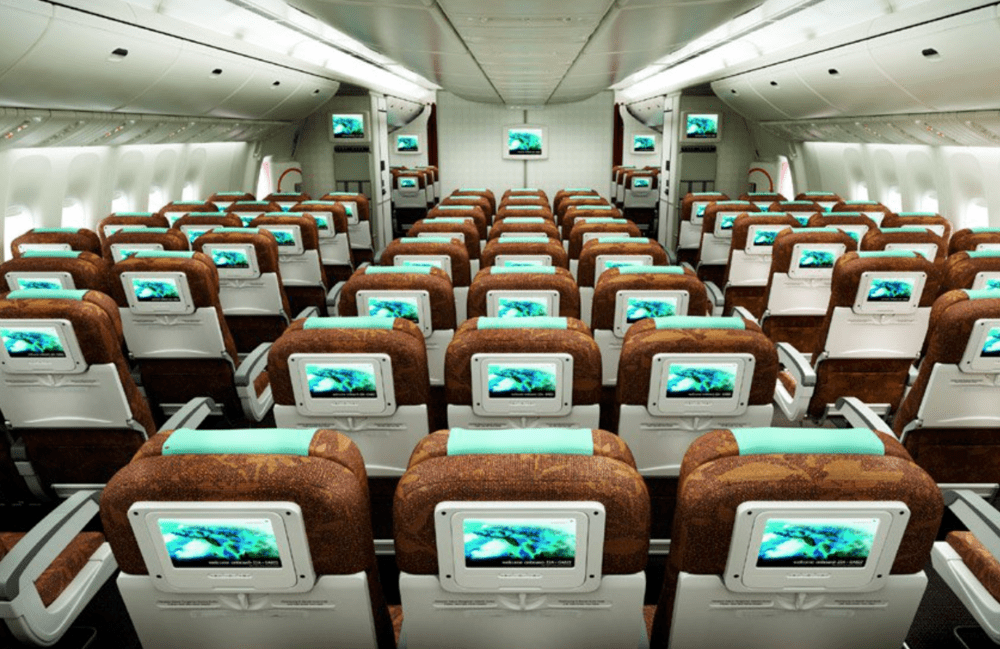
Garuda economy class.
5. Cathay Pacific. I LOVE Cathay Pacific. I’ve flown them at least a dozen times in business class, and once in coach. The award-winning airline based out of Hong Kong has exceptional service, seriously great food (often better than the business-class lounge), and nice, cozy seats. Cathay Pacific is considered among the best airlines in the world, much credit to its hospitality. While business class is pretty mindblowing (passengers have their own pod), economy is very good.
What you can expect:
-While flight attendants on many airlines are super old school (and so over it), the crew on Cathay Pacific is young, able, eager and very professional. Press that call button and you’ll get someone fast.
-The planes have a 3-3-3 configuration (as opposed to many competitive airlines, that have 3-4-3 or even 3-5-3!). Because it’s a 3-3-3 configuration, seats are huge! 18.5-inch wide and 32-inch pitch.
-Seatback entertainment with really good clarity of picture, and huge selection in many languages.
-Universal power plug at every seat! You don’t have to bring a convert on board when traveling internationally.
-Great Chinese and Western food, and tons of snacks mid-flight.
-Extremely streamlined check-in process.
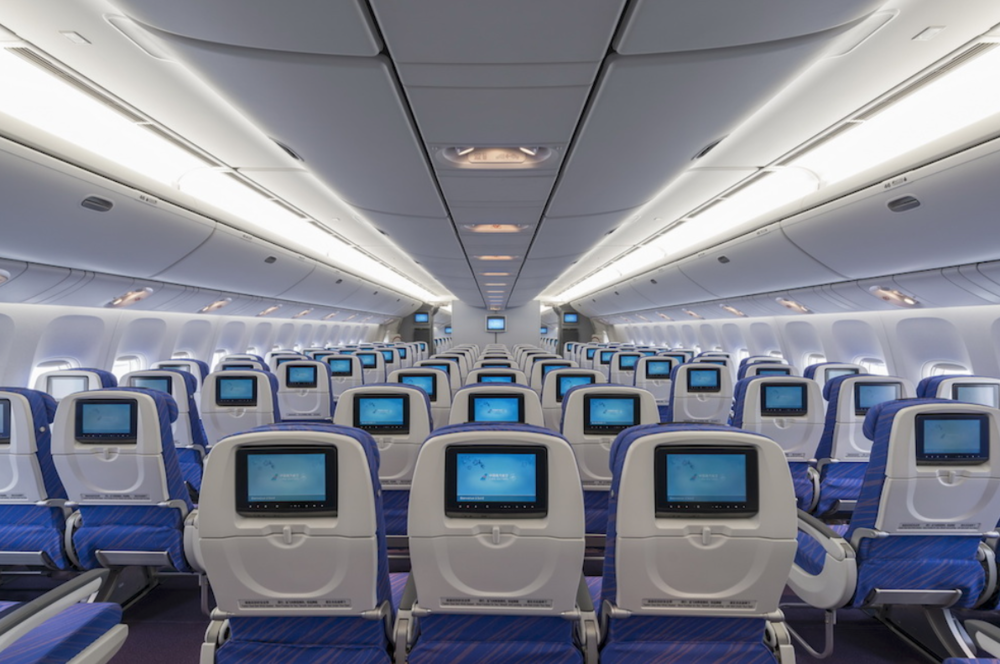
Cathay Pacific economy class.
6. ANA. I’ve flown ANA (All Nippon Airways) several times, and this Japan-based carrier is truly impressive. They don’t have as many routes in the US as, say, Emirates or Cathay Pacific, and I also think they don’t have a huge marketing/PR budget because they just don’t get that much attention. ANA is a superb airline, and it’s a shame not a lot of Americans know about them. They are one of 7 airlines ranked 5/5 of best airlines in the world, and they even beat Singapore in ratings (back to the PR/Marketing thing.. Singapore has a great team behind their communications, so everyone in the US knows about them, where ANA doesn’t. They have about the same number of routes in the US, so see how marketing/PR really does work here?)
What you can expect:
Amazing service.
Most of the planes are new (either 777-300 or 787 Dreamliner). This automatically makes the coach class one of the best. Quiet as a whistle, sleek design, bigger bathrooms, power ports at every seat, award-winning entertainment system with seatback entertainment.
Amazing food, both Western and Asian.
Footrest, blanket, pillow at every seat.
9-inch TV screen.
34 inch pitch, which is quite roomy.
Great service. Coach comes with at least 12 flight attendants.

ANA economy class.
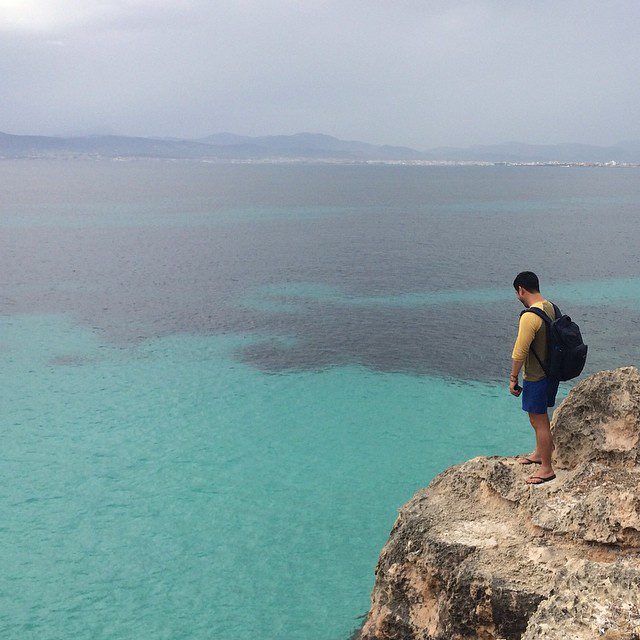
I’ve stayed in more than 1,000 hotels, from five-star properties and centuries-old castles to hotel pop-ups and bunks on cargo vessels (yes, weird!). The chances of me having strange moments are pretty, pretty high, and I’ve had some of the weirdest things occur.
Someone recently asked me what my strangest experience at a hotel was, and I didn’t have one answer. Many, many, many situations came to mind, but some stand out more than others. Behold: the strangest, weirdest and most *interesting* things I experienced in hotels! While we’re here, if you had any strange or interesting hotel moments, I’d love to hear them in the comments below!

Wow! Weird!
The strangest, weirdest, non-normal and most *interesting* things I experienced in hotels!
1. Abu Dhabi, UAE. I stayed at a very posh, five-star hotel in Abu Dhabi. One night, I heard the sound of the TV in the room above me. It was loud, a lot of grunting. I opened my patio door to discover it was not the TV but in fact the Russian couple upstairs having really loud sex with their patio door open, and the woman orgasmed several times. I remember thinking: this dude must be great in bed.
2. Bimini, Bahamas. In 2011, I stayed in a hotel in Bimini, Bahamas, where I woke up in the middle of the night because a man was laying in bed with me. It was dark, but I could make out his silhouette. As my eyes focused, I saw he was an older man with a kind face and he sort of smiled at me… until I threw a pillow at him and he disappeared.
3. Amalfi Coast, Italy. I was staying at a very luxurious, five-star hotel in Amalfi Coast, eating at the Michelin restaurant on the outdoor terrace with a handful of other diners when the outdoor jacuzzi on the rooftop above us mysteriously exploded, and the jacuzzi water poured all over us.
4. Edinburgh, Scotland. In 2007, I visited Edinburgh, Scotland, which is home to centuries-old castles, including Melville Castle, the castle hotel I stayed in, which is pretty famous. The first night in, I had trouble sleeping because I heard talking, assuming it was guests in the next room (the castle dates back to the 1700s, so the walls are thin). When I finally got to the point of sleep, I felt a strange presence, like when you know someone is watching you. I opened my eyes, freaking out when I saw a Tartan robe in front of me, then relaxed because it must have been hanging on the back of the door. I went to use the bathroom, came back to bed and basically died right on the spot: The robe was gone. I later found out from hotel staff a woman in a Tartan dress haunts the place, so I must have seen her ghost.
5. Atacama Desert, Chile. I was at a new boutique hotel that had just opened in San Pedro de Atacama, a gorgeous desert destination known to have the clearest skies in the world. About an hour after checking in, I suddenly got very, very, very tired. This was around 5 pm. It wasn’t jet lag as there was no time zone difference from NYC, where I flew from, and I had been in Chile already for a few days. This sudden tiredness just came out of nowhere, almost like I was fainting, and I lied on my bed. It was the first time I had every gotten “sleep paralysis.” I was conscious, but I literally could not move, as if I was a magnet to the bed or a pinned-down bug in a science project. During this time, I saw native people across the room. One by one, they came to sit next to me, looking at me as if they couldn’t believe what THEY were seeing. When it was over, I felt that hours had passed but it was only 20 minutes. I later discovered, after nagging the hotel manager about this crazy situation, the hotel staff had found graves under the hotel during construction.
6. Auckland, New Zealand. Who doesn’t love meeting new people? When I was in Auckland, New Zealand, another travel writer and I were out late and made new friends. Two of them had never seen the hotel I was staying at, so we went up to my room for a nightcap. Little did I know they were prostitutes, and they were actually “working,” assuming they were hired for the job. I kicked them out. Fun note: At the same hotel, I was leaving the gym the next day. When the elevator arrived, a security guard wouldn’t let me inside. I was like WTF when I saw, behind him, Justin Bieber texting on his phone.
7. Marquesa Islands. I was aboard a cargo vessel (yes, a cargo vessel), sleeping in my bunk when I felt a tap on my face. I opened my eyes to this insanely bright white flash that didn’t even last a full second. Toward the end of the trip, I learned a crew member had a tragic and fatal accident months ago, and some people have sworn to have had strange experiences too. I didn’t realize ghosts could actually, physically touch you.
8. San Ignacio, Belize. I was at a luxury resort in the rain forest of Belize, lying outside to stargaze because the clarity was so good. I was baffled when I saw a very strange, triangular object hovering in the sky. I know it sounds crazy, but it definitely was not a plane or satellite—it was pretty huge. It sort of moved around in unusual motions (far, then close, then far, then close), and there were three lights attached to it. I know for a fact I saw a UFO (literally: Unidentified Flying Object), and I was not the only one who saw it. The next day, we went to do yoga at a pyramid. The first thing the yoga instructor said to us was: “Did you see that crazy in thing in the sky last night?!” Even later that night, when I was speaking to the hotel staff about dinner, she asked the same question: “Did you see the thing in the sky? We got about ten calls from locals asking us if we were responsible for the thing in the sky.” CRAZY!
***BONUS*** While this isn’t strange, it was certainly interesting. In 2013, AirBnb had collaborated with celebrities to do AirBnb pop-ups throughout Los Angeles. They asked me to stay overnight at The Grove, a high-end shopping center. The AirBnb pop up was designed by actress Molly Sims, and I interviewed her before I settled in my glass pop-up hotel room, where literally everyone there could just watch me. When the crowds cleared around 10 pm, I had my own security guard just make rounds while I… slept. To this day, I am literally the only person to have slept at The Grove!
I wrote about it for Hollywood Reporter, and you can see a rendering of the pop-up here.

Sexual abuse, assault, harassment and mistreatment by notable chefs is rampant lately. Everyone from Mario Batali to John Besh have been accused and proved their guilt with apologies, confirmation of claims or simply stepping down from their empire. In one hand, it sucks because they were our heroes and inspired other chefs around the world. In the other, they were fueling and perpetuating discomfort, fear and abuse in the restaurant industry by being sexual predators. This is some serious shit, and I’m glad stars aligned in the universe to call them out. Sexual harassment is fucked up, and it will come back to haunt you.
At this point, with so many chefs under fire, I wasn’t surprised with the newest allegations against restauranteur Ken Friedman, who runs The Spotted Pig (among many other award-winning restaurants) but I was shocked executive chef/partner April Bloomfield (note: NOT an old white man) knew all about it. In a story covered by New York Times, staff reported they were constantly harassed and went to April to complain but she basically responded: “Get used to it or find another job.” Then, after that went viral, she went on record with a formal apology that was shockingly dismissive. Wow. What a bitch. It reminds me of the time Paula Deen gave her first “apology” for being racist.

Anyway, April and Ken had just opened their new restaurant, The Hearth & Hound, in Los Angeles last week. It actually looks awesome. But should you dine there considering April and Ken promoted sexual assault for years, including knowing about an alleged “Rape Room” at their restaurant The Spotted Pig?
Here’s the thing. Would you eat at a restaurant the owner discriminated gay people? Would you eat at a restaurant that refused service to black people? Would you eat at a restaurant run by the Taliban? The only reason these restaurants were successful in the first place is because of the people dining there. When you’re helping support these sexual predators, you’re part of the problem and helping enable it. If we dismiss this altogether, how does it prevent it from happening again in the future? The guilty chefs shouldn’t get off so easy. Issuing an apology is something the publicist manages, and it takes guts (and character) to truly accept the bad behavior they enabled (like John Besh, who stepped down from the restaurant group he created). April Bloomfield is trying to push this under the rug (the same way Mario Batali issued an “apology” in his email newsletter which shamelessly promoted a recipe to his cinnamon rolls). These chefs need to understand terrible actions have consequences, and if we continue to eat at their restaurants, they will feel like the whole thing just blew over, no lesson learned.
A racist like Paula Deen doesn’t deserve success, and neither do chefs that allowed sexual harassment in their restaurants. There are a LOT of great chefs out there who are good human beings and should get the deserved spotlight.
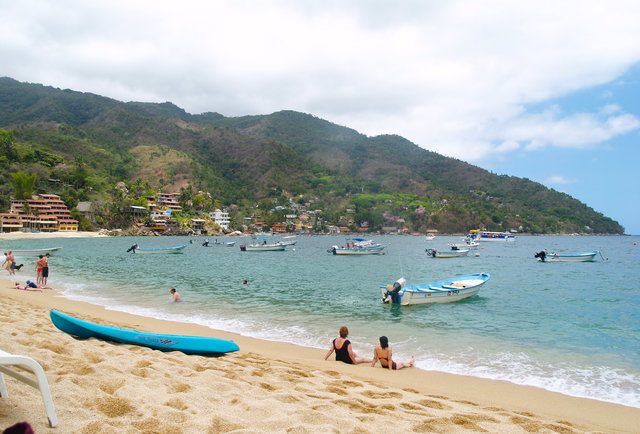

If you haven’t explored Yelapa, you haven’t experienced paradise. Photo: Flickr/Ernest McGray Jr
My story on Yelapa for Thrillist, as appears March 2016
THE UNSPOILED NORTH AMERICAN BEACH PARADISE NO ONE KNOWS ABOUT YET
Jimmy Im
Mexico is inarguably home to North America’s best unspoiled beaches (sorry, Redneck Riviera — it’s true). But because many of these strips of tropical paradise are worthy of your screensaver, they haven’t stayed magical for long. Perfect beaches equal swarming crowds. MTV killed Cancun in the ’90s, hipsters currently riddle Tulum, and Sayulita is now a hot cruise ship port of call.
So, where exactly can you get your tan on in Mexico without having to deal with chain restaurants and American spring breakers?
One word: Yelapa.
If you haven’t heard of this tiny beach haven in Puerto Vallarta’s Bahia de Banderas, that’s a good thing. It has gone decades without the infiltration of obstructive high-rises or a mass influx of tourists. Some say it’s Mexico’s last authentic beach town, and we’d agree. So much so that we put together these eight reasons why it’s absolutely the country’s top undiscovered stretch of sand.
You can only get there by boat
Twenty miles south of Puerto Vallarta, Yelapa is so off the radar you can only arrive by boat. Most travelers hire a private charter from Boca de Tomatlan or take a water taxi from Los Muertos Beach, and they often stop en route at Majahuitas, a popular snorkeling spot. And when visitors do finally arrive in Yelapa, the boat pulls right up onto the beach. Who needs a dock?
There are no chain restaurants, bars, or hotels
The only businesses in town are locally run and include about a dozen beach bars/restaurants and a handful of small hotels. Unlike other “undiscovered” beach towns, which may have an OXXO gas station or Subway, Yelapa still feels “pre-tourism boom” retro, without any souvenir shops, to boot.
Did somebody say beach pies?
What really put Yelapa on the map for locals is not tacos or chimachingas or even Mayan ceremonies — but pies. Yes, fresh-baked pies. Two local bakers strut up and down the beach daily selling a variety of flavors, from coconut to cheesecake. They are like the ice cream trucks of Yelapa, and visitors can score a slice for a mere $2.
All the fresh seafood, none of the inflated prices
It’s a town of villagers who make their money foraging and fishing. All the seafood you eat there is caught fresh from local waters, and sold well below typical resort prices.
It’s a hotspot for raicilla
You may not know that raicilla, a type of once-bootlegged mezcal, is all the rage in Mexico. Recently re-discovered (it’s been around pre-Spanish days), raicilla is reportedly twice as strong as mezcal or tequila and known to cause mild hallucinations (consider yourself warned). It’s not easy to find in Puerto Vallarta, but it pours freely in Yelapa. Salud!
It’s not overrun with tourists
Sure, beach bums who have been coming to Yelapa for decades argue that there are now more tourists than ever, but that’s not saying much. And while some booze cruises often drop their passengers off for a few hours, Yelapa remains decidedly notoverrun. The beach is long and wide, visitors sprawl out, and it’s still far enough off the beaten path that there aren’t any high-end restaurants for Anthony Bourdain to deem the best in Mexico. At least not yet.
The beach: gorgeous and perfectly bareboned
The crescent-shaped stretch of sand straddles jungle and ocean and is lined with lounge chairs, a few umbrellas, and nothing else. Just steps inland are a handful of thatched-roof, al-fresco bars and some swaying hammocks under the palm trees. From anywhere you kick your feet up with Pacifico in hand, you hear the crashing waves and little else.
Bob Dylan used to hang there
OK, regardless of whether this is a selling point or not, it’s true. Bob Dylan, Dennis Hopper, and even dudes like Roland Emmerich (who directed Independence Day) have all escaped the crowds on this undiscovered beach at one point.

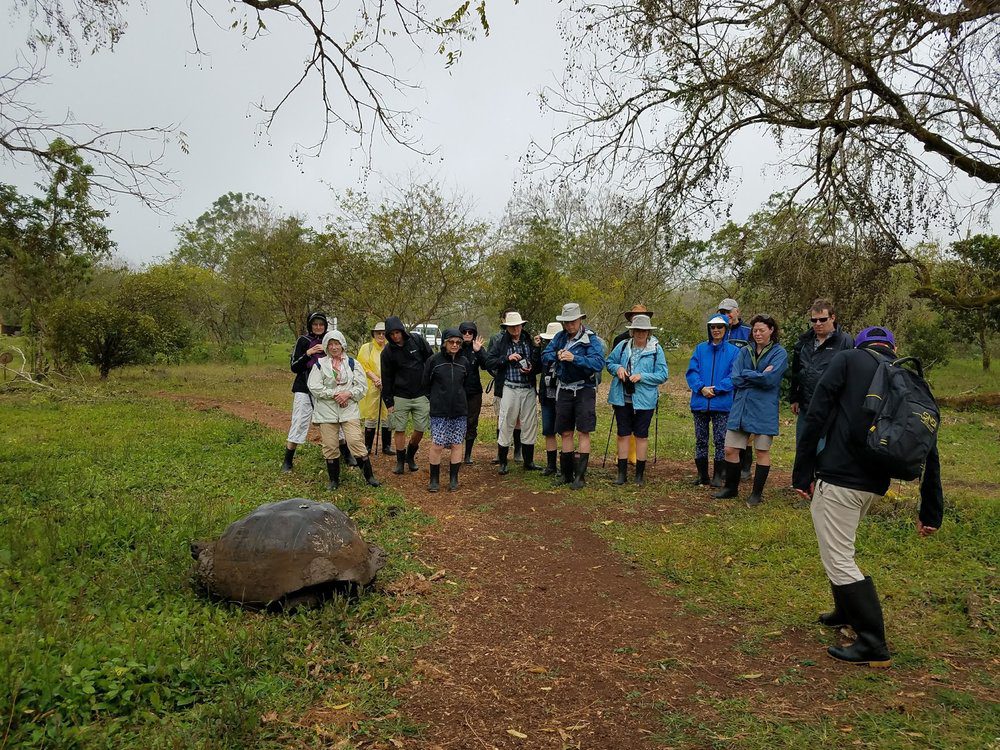
Travel writers or travel influencers?
Everyone has been asking me to clarify the difference between travel writers and travel influencers. While I believe, to some degree, it’s pretty obvious and the two rarely merge, I thought I would focus on the impact these two have (and don’t have) because it’s actually not what you’d would think.
With the rise of social media (particularly Instagram), travel influencers have been popping up all over your feeds. They take amazing photos and offer great visuals on their travel experiences, whether it’s a luxury hotel or a beautiful destination. The higher their following, the chances of them getting paid are greater, so it can turn into a career.
On the other hand, travel writers tell a great story, bringing you into the destination with their prose and offering a sense of authority on what to do, eat, play and sleep. Travel writers spend hours, weeks and even months reporting on a story, dedicating a lot of time while making sacrifices for their passion.
While it’s rare to see a travel writer with a huge Instagram following, you won’t find a travel influencer with a lot of knowledge behind they’re photos. Travel writers don’t need to take great photos for their stories (it’s mostly handled by the photo team for the outlet they’re contributing to) while travel influencers don’t have to know any history, culture or whether something is UNESCO or not as long as their photo gets a ton of likes (how do I know this? I’ve traveled with dozens of great travel influencers who have proven it. Getting the perfect room service or standing on a balcony photo is priority over facts).
That’s the biggest difference between travel writers and travel influencers, but there’s something a lot bigger. While I love the work of many travel influencers, they ironically have very little influence. I call them “visual storytellers.” Let’s say a travel influencer with 50K followers gets hosted in a luxury hotel and takes about three great photos. They’ll get a ton of “likes” but very few (if not any) of their followers will actually book that hotel. They can certainly inspire you and encourage you to travel, but most followers know they worked hard behind-the-scenes to get that hotel stay for free.
On the other hand, travel writers actually have major influence. They work for magazines that serve as experts and authorities. They want to inspire you through writing. They are too busy traveling, writing, pitching, exploring, researching, interviewing and editing to take photos so they can get the best stories to inspire readers to book certain hotels, restaurants, activities and dream trips. The problem with travel writers, however, is that they’re a dying breed. At this point, with the state of the publishing industry, there are very few outlets that hire or even pay well, nobody wants to read long stories anymore and it’s hella competitive. You see fewer travel writers these days because it’s hard to be one, so the art of travel writing is becoming extinct. They don’t have the platform that travel influencers have.
But what if travel writers and travel influencers were able to work together in some way? Do you think that will be the next big trend in how we read travel stories?


Amantaka in Laos.
As much as I travel for work, I like to carve out time for a vacation (ironically, my job is not a vacation! Unless you consider running around cities, attending three-hour meals with managers, taking notes, hotel tours, early AM wake-up calls, making time to write stories on the spot, finding story angles, constant social media, gaining weight and little time to exercise = paradise). When I do have the time to plan a vacation, I’m in the same boat as you. Where do I start??
Choosing a destination to spend your next vacation is not easy. There’s stiff competition among hotels, airlines, tour operators and now vacation rentals, all of which fight hard to get your tourism dollar, and it’s easier to get to places you couldn’t imagine a decade ago (with better flight connectivity). In English: there’s an incredible amount of great options, making it hard to decide where to go. It’s like going to an ice cream parlor and stressing over what flavor to get. It can be overwhelming. You don’t want any regrets (but, uhhh, go for Rocky Road).
I help dozens of friends, friends of friends, readers, extended family, colleagues and even strangers help choose a place they’ll love, but I know it can be stressful planning if you don’t know someone who can give solid tips. So I created a list of five questions everyone should answer to ultimately decide on the perfect vacation spot.
Five questions to ask yourself when planning your next vacation

Sedona, Arizona.
1. What are your top ten fantasy trips at this point in time?
Your list doesn’t necessarily have to include your “bucket list” (places you have to see before you die). Think of the places you want to visit now. Why? These are the places that will definitely make you instantly satisfied. Picking the top ten is quite possibly the hardest part, but think about where and why you want to go. City? Beach? Private island? Skiing? Down Under? A new luxury hotel you’ve been dying to check out? A food truck in a jungle everyone has raved about? When you ask yourself why you want to go, if you can’t find a good enough reason, it should not be on your list right now. I highly recommend visiting a place you’ve never been to rather than a place you already love (you can always go back there.. why not try something new?). Also, be as specific as you can be. For instance, don’t think “Hawaii” but rather “Maui.”
Write down the top ten. Now cut that in half. It’s tough, but this will help you identify the five places you really want to visit.
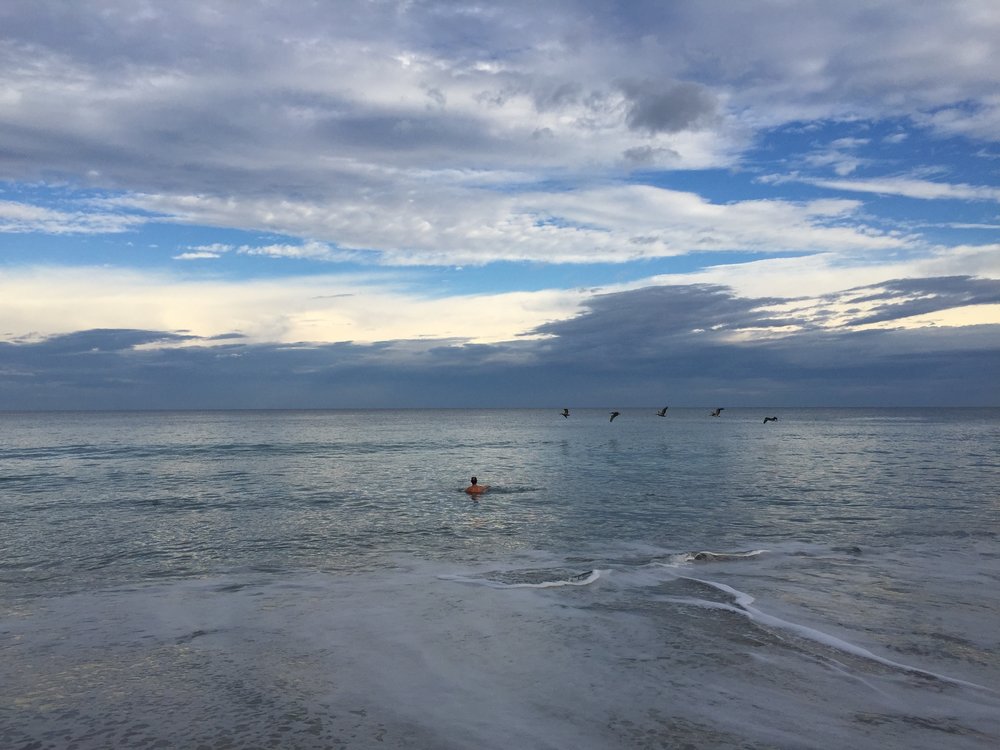
The beaches of Riviera Nayarit, Mexico.
2. How much time do you have?
Unfortunately, America has a notorious low percentage of passport holders because Americans have very little vacation days. If you plan on going overseas, get your passport NOW. Based on the five places you want to visit, you should figure out what makes sense in terms of how much time you can spend there. If time is not an issue, you’re golden. If it is, narrow your list even further down to destinations easiest to get to (for instance, if Hawaii and Thailand are on your list, go with Hawaii for now, as you lose two days going to Thailand). If money is not an issue, and you can group your vacation with Christmas (when hotels are at their most expensive) or Thanksgiving (when flights are expensive), you can have a longer vacation using your vacation days.

Four Seasons Bora Bora in Tahiti.
3. Is now the best time to go?
High-season destinations will be more expensive to travel to than off season (for instance, in winter, high-season would include tropical destinations like Mexico and Hawaii. Off season for winter would be cities that will be crazy cold like Copenhagen or southern Italy). You don’t want to go somewhere during rainy season as you have the chance of ruining your entire trip due to weather. Also, are there cheap flights? Can you get good hotel rates? Is there a big city event that has all the hotel rooms sold out? Within your five top destinations, figure out which ones pass all these questions and are places realistically suitable to visit now.

Underwater restaurant in the Maldives.
4. Who do you want to travel with?
Trust me. It’s better to decide who you want to travel with AFTER you pick the destination. Otherwise, you’ll be doing a lot of compromising that could take you back to square one. If you’re already planning your next big vacation with someone else in mind, then do all the questions together from the start (it might be trickier, which is why we recommend asking them after you’ve chosen the top five and dates.). Think about who you’d want to be with on this vacation. Lover? Family? Kids? Grandparents? The guy that works at Dunkin Donuts? Or do you want to be alone? Make sure your travel companion is someone who will appreciate where you’re going. They are also great in helping narrow down the top five. Chances are they’ll want to visit at least one of those places. Again, choose your travel companion after you have the top five (or agree to do it together). It’s so much easier that way.

Sunset at Four Seasons Papagayo, Costa Rica.
5. How much planning do you want to do?
Now that you’ve likely narrowed down the top five to your fantasy vacation spot, think about whether you want to do all the planning or leave it to someone else. Travel agents have made a huge comeback and, in most cases, it doesn’t cost you a penny to use them. Virtuoso agents are the most qualified in terms of luxury travel, and customers get free room upgrades, breakfasts, etc, just from working with one (they get commission). Otherwise, you can hit the ground running as soon as you arrive with recommendations on restaurants and attractions from locals, concierge and friends who have visited.

Resort at Pedregal in Los Cabos.
Have a great trip!

In 2017, I stayed in 42 hotels, took 26 trips, flew 70,000 miles, attended 3 travel press conferences, interviewed 163 travel industry folk and rented 1 car! I had little snags, but travel in general was ridiculous. People were dragged off planes, racism was rampant and, of course… TRAVEL BANS. Thankfully, 2018 was good and 2019 seems to be a lot more promising — and this is why.
10 amazing reasons why travel will be better in 2019!
1. CHEAPER AIRFARE… Finally, some good news with airfare! Low-cost airlines (like Norwegian, Southwest and Volaris) are expanding like crazy in the US, so major airlines (like Delta and American) will be forced to lower fares to remain competitive. This means the fare wars will be on in 2019, and you’ll definitely find cheaper fares across the board on many routes.

Hey, you will get a great deal on business class seats in 2018!
2. More authentic experiences. AirBnb‘s famous marketing campaign promoting “authentic experiences” tipped the industry in this direction, and now hotels have joined the movement. Whether they’re partnering with local purveyors (from products used in the spa or a carefully curated mini-bar) or showcasing local art and regional cooking in restaurants, hotel brands are seeking authenticity.
3. Better security. In 2017, there were really sad moments in travel that targeted tourists (like attacks in Barcelona, New York City and even a shooter in Las Vegas) so security improved in major tourism destinations for everyone’s safety.
4. Most of the Caribbean will be back on track. It takes time for hurricane-struck destinations to get back on track, particularly post-Irma and Maria. Thankfully, many island nations are gradually pulling together for tourism again. For instance, the airport and seaports in British Virgin Islands finally re-opened this past November, and Puerto Rico is optimistic for 2019.
5. INSANE new hotels will open. 2019 will be an amazing year for unique, over-the-top and luxury-drenched new properties. One of the most anticipated, Rosewood Luang Prabang (designed by one of my favorite hotel designers, Bill Bensley) opened with villas and luxury “tents” strategically staggered out in the forest. In one of my favorite Mexico destinations, Four Seasons Los Cabos in Costa Palmas opened on a breathtaking, swimmable beach, and Bishop’s Lodge (Auberge Resorts) in Santa Fe reopened after a multimillion renovation, destined to be a landmark hotel.
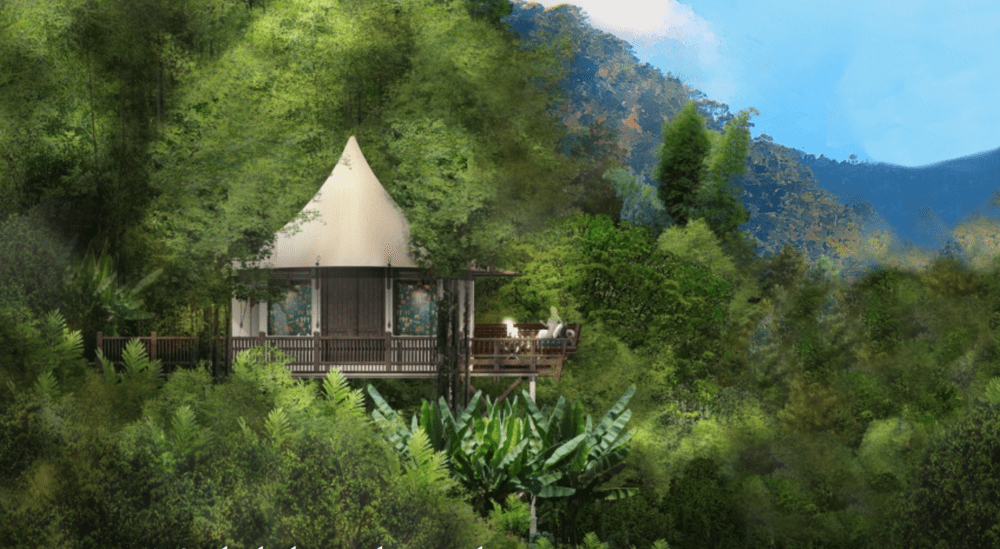
Rosewood Luang Prabang.
6. You’ll see less cookie-cutter hotels. Large hotel chains like Marriott and Sheraton are starting to realize more travelers prefer “authentic experiences” over brand loyalty, so you’ll start seeing newer properties more interesting, to say the least. Whether it’s having Instagrammable features, exciting chefs, memorable design or cool technology, the way of the bland, cookie-cutter hotel will be history.
7. You’ll see more hotels become actual tourist attractions. At Intercontinental DTLA, there are more tourists lining up for the insane views than actual guests in the hotel (we’re talking thousands). Same over at 21c Museum Nashville, which moonlights as a free and public art museum. You’re going to see a LOT more hotels spend millions of dollars to open in landmark buildings or do whatever they can to stand out, like Alila Fort Bishangarh, a hotel inside an actual, 230-year-old fort outside Jaipur, India.

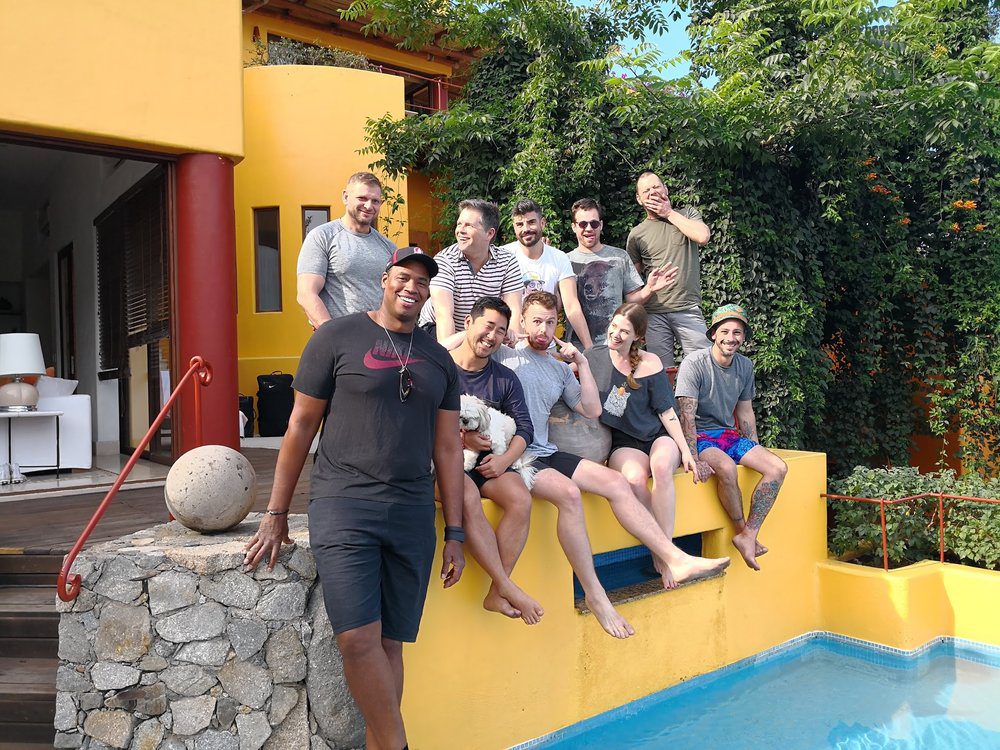
My Puerto Vallarta birthday crew.
I had the joy of celebrating my big 40th birthday in a private, 10-bedroom villa in Puerto Vallarta, Mexico, with 11 close friends (many of whom I’ve known for 15 years!). I wouldn’t have had it any other way. In fact, when I first started looking at hotels for my birthday week, it felt somewhat…. wrong. My friends and I are just too close and, despite the fact I primarily shack up in luxury hotels and resorts, I knew I had to be at a private vacation rental (and fate had determined it would be Villa Mandarinas, which was the best experience EVER).
To be honest, there’s no other way I would have celebrated my birthday.
Here are five reasons why you might want to consider a vacation rental over a hotel for a special occasion or big group of travelers.
5 reasons to book a private villa or vacation rental over a hotel or resort!
1. A vacation rental is so much more intimate. When I was scouting for birthday properties, I knew it had to be perfect… and special. I had friends flying in from London, Los Angeles and New York City, friends I don’t see that often. I wanted us to be in a space where we could wake up and see each other right away (as in, no walking long hallways, different towers, etc). I also didn’t want anyone annoyed with resort woes, like big families sitting in the hot tub, rooms that may have not been luxury enough or staff seemingly everywhere. I wanted a kitchen where we could maybe make our own quesadillas, a private pool where we could catch up and hang and all the other intimate perks you get with a private villa rental.
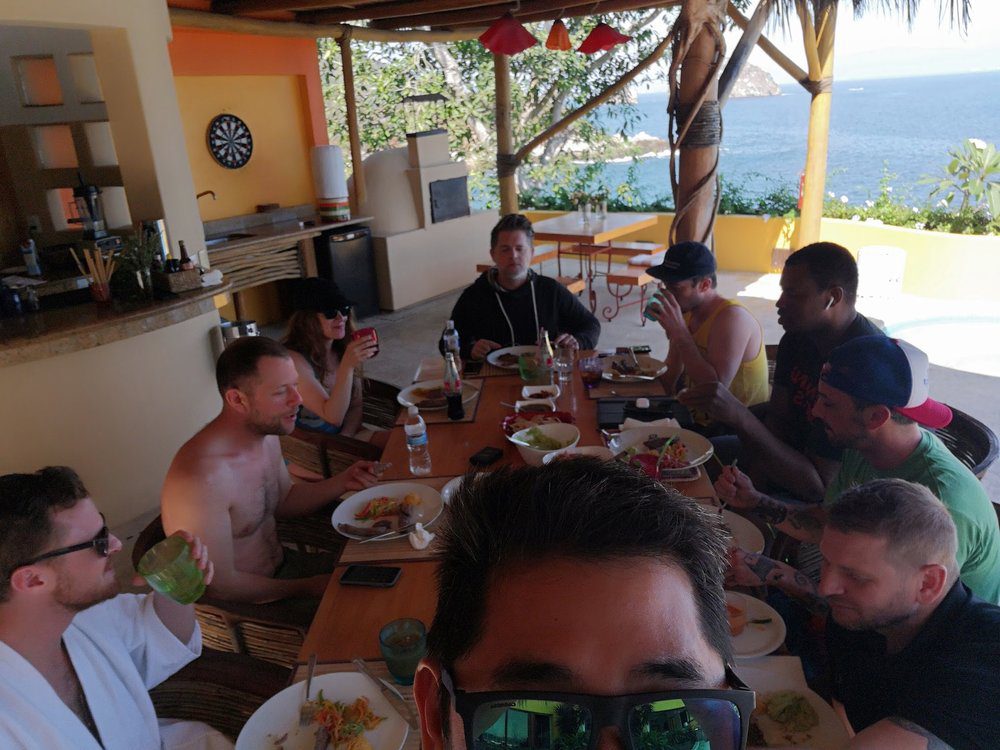
This is us at lunch, being relaxed and casual!
2. I wanted everyone to be completely pampered. Here’s something not a lot of people know. When you book a private villa in Puerto Vallarta, you’re going to get your own dedicated staff. The staff will include a private chef, housekeeping, a villa manager and even bartender. You don’t lift a freaking finger, and it’s all included in the rate, which brings me to number 3.
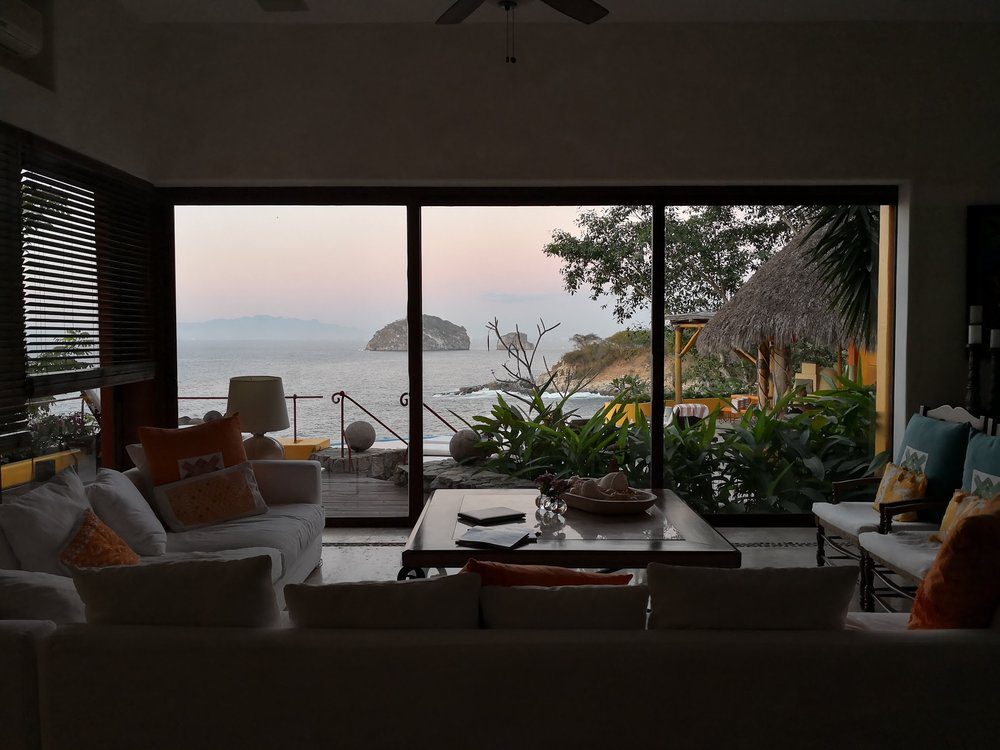
Look at the view from our main living room.
3. Vacation rentals are all-inclusive. Not only do you get private staff, your gourmet Mexican food (cooked up by your private chef) is included in the rate. There are no hidden fees or resort fees. ALL cocktails and beverages are included (pre-arranged), as well as WIFI and tips. In many cases, you pay for your food in advance (which the team will stock up on before you arrive) but it’s a lot cheaper than eating out.
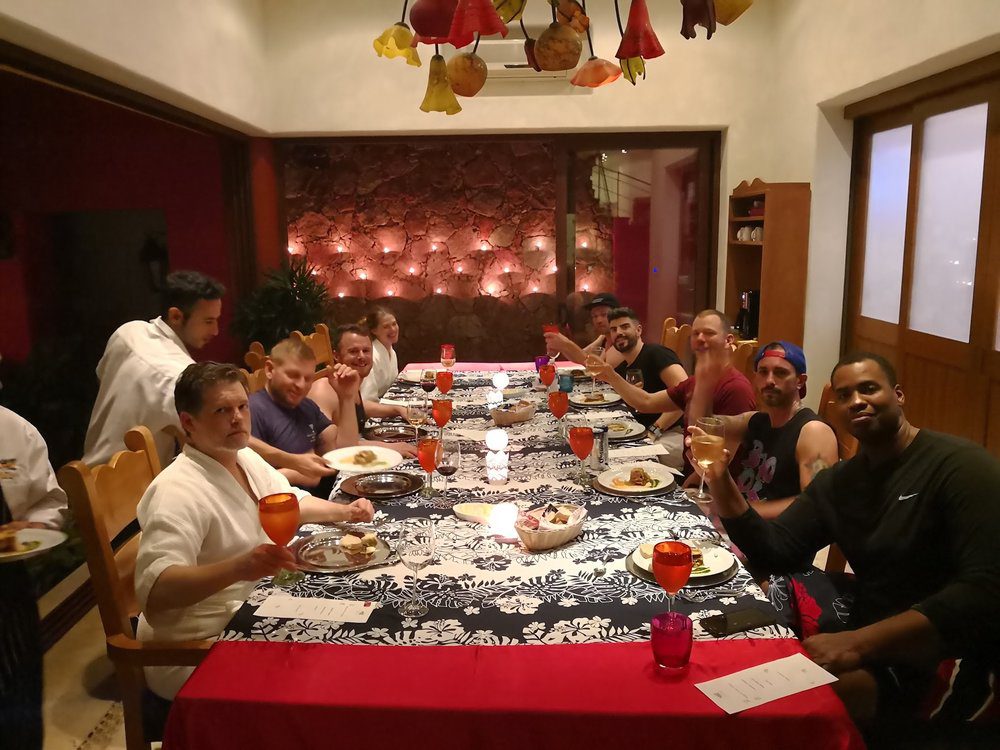
Included in our rate was amazing, home-cooked gourmet Mexican dinners.
4. In a vacation rental, you have tons of privacy and don’t have to share resort amenities with strangers. At our private villa, as well as many private villas I’ve stayed at, you have the beauty of arranging private, ocean-front massages (which are more than half what you’d pay at a resort), have the pool to yourself, recreations to yourself and bar to yourself. It’s the perfect set up if you’re with an intimate group of friends or family, and there’s literally NO STRESS in your vacation.
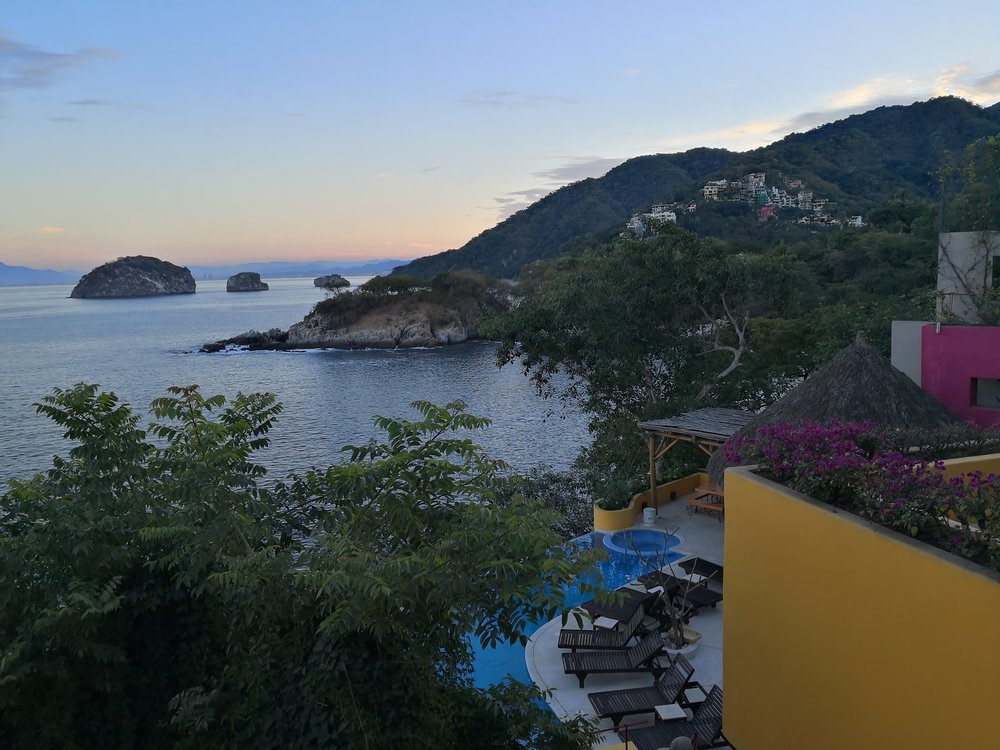
This is just one of TWO pools we had all to ourselves.
5. It’s a HELL OF A LOT cheaper. For the five nights at Villa Mandarinas with 11 guests, it worked out to about $360 a night, which is substantially cheaper than the hotels I was looking at (average $500 a night, and NOT all inclusive). It’s not rocket science. The beauty of private villas is the high level of value and how you end up saving a lot more money than hotels if you have a larger group.
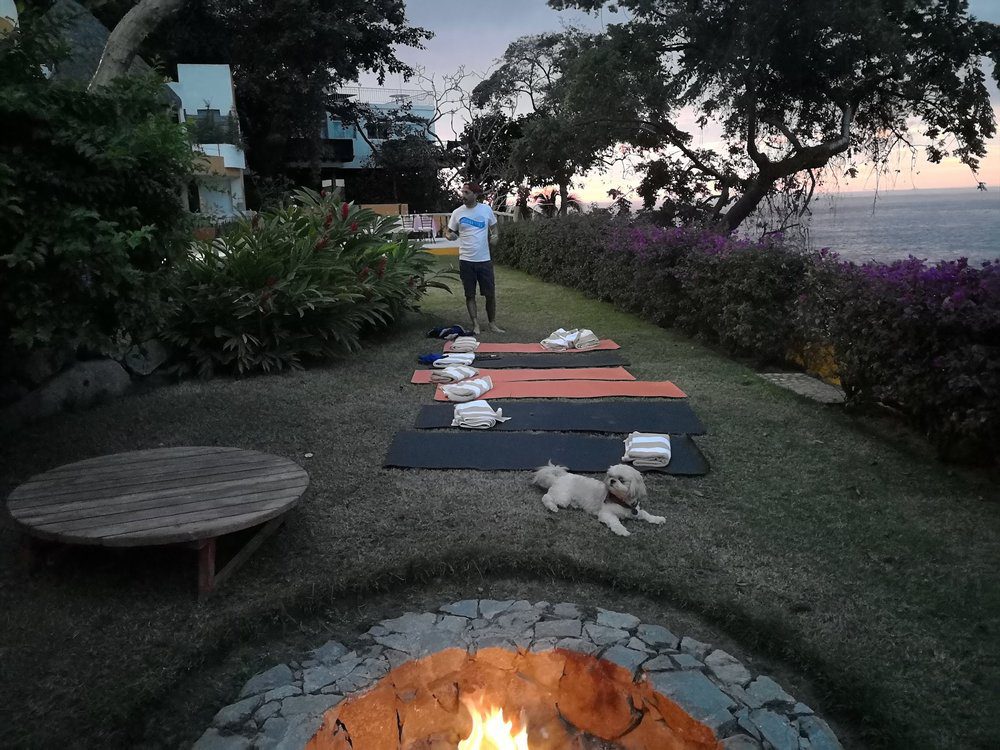
We arranged a ton of special things, like this sunset meditation. IT was all for us!

How do you choose where to eat in Nashville when the city is home to so many amazing restaurants?
I have a weakness for Southern food. Give me buttery grits or a biscuit drenched in gravy, and it’s instant #foodporn. Southern food and I go way back; we have history. I grew up outside Atlanta, Georgia, where the Waffle House was my stomping ground as a teen. Raised in a Korean household, I ate ban chan and bulgogi almost every day and have no regrets. My mom was an amazing cook, but when she brought home a bucket of fried chicken, it was a miracle if the chicken bones survived. There was always a bottle of Louisiana hot sauce on the table at every meal, and it was mine. It would go on everything, especially when my mom cooked meatloaf with green beans or chicken-fried steak with sweet potatoes. It’s not far off the mark to say I learned to love food through Southern dishes. There’s a level of comfort and nostalgia with every meal, no matter where I am in the country, and it truly resonates with iconic chef Anthony Bourdain’s famous quote: “Context and memory play powerful roles in all the truly great meals in one’s life.”
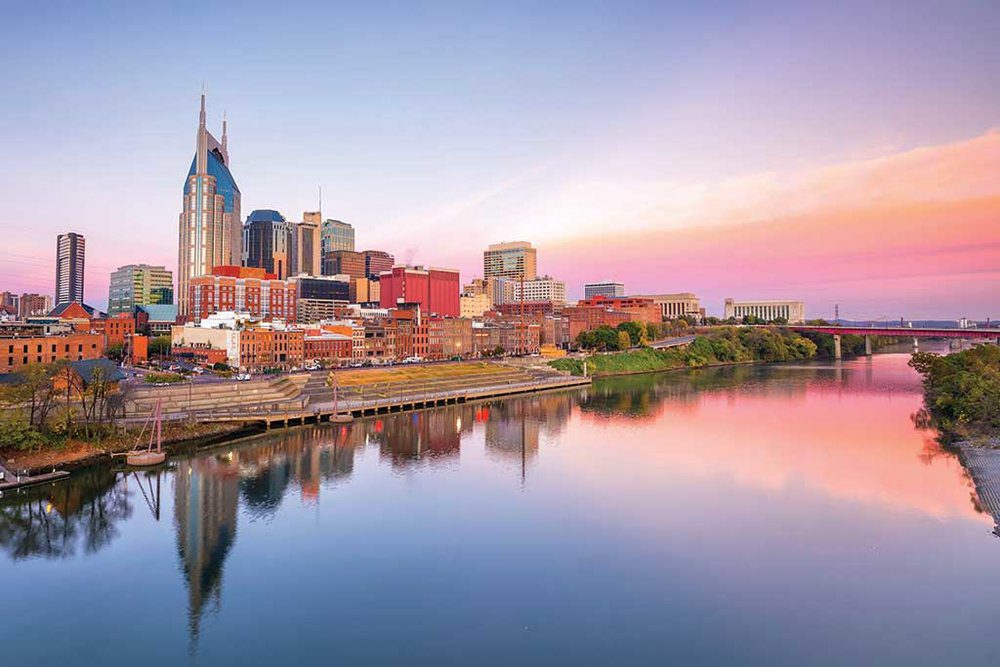
Every time I plan a trip to Nashville, I arrange my itinerary around the restaurants I’ll dine at. Nashville may have a reputation for its music history, but any foodie or gourmand knows the restaurant scene is what makes the city truly special. Notable chefs have elevated Southern classics, yet you can still nom on nostalgic comfort food at a simple café. When I’m in town, I’m hashtagging #foodporn to an obsessive level, but it’s all warranted. Nashville offers some of the best Southern food in the country. Restaurants here also have heaps of personality, and foodies are treated with trademark Southern hospitality, which historically has revolved around a great meal. Nashville is also growing faster than any other city in the south, so visitors have more reason to eat their way through the city. Thompson, Westin, and 21c Museum Hotel have recently moved in, and Kimpton and Virgin are on their way. Complementing the expansion of the tourism landscape, the culinary scene (the real heart and soul of Nashville, in my opinion) gets better every year. It has the power to move you, inspire you and, like me, make you fall in love with food. From longstanding institutions to new, buzzing hot spots, the restaurants featured here are taking dining to the next level. Read the entire story I wrote here, originally published in Passport magazine.

These are the best hotels to book in Las Vegas…
Do you really want to gamble at a “meh” resort in Vegas?
I think not.
Most people who plan Vegas trips either go for “below budget” friendly or gangbusters luxury. If you’re reading this story, you’re definitely not creeping on the Circus Circus website.
I’ve traveled to Vegas a dozen times now, and I’ve stayed at the best of the best on the strip. I know there’s an overwhelming number of properties to consider when you’re booking, so I went ahead and weeded out the creme dela creme. Taking into account the level of luxury, dining, spa, rooms and service, these are the only five properties I’ll book again and again when visiting Sin City.
1. Aria. Everyone loves Aria, and it raises the bar on swank casino resorts. It’s AAA Five Diamond and Forbes Five Stars, so you know you’re getting your money’s worth. Aria also has mind-blowing suites like Sky Lofts and Sky Suites, which feature a massive living area, kitchen and killer views (see photo). It’s also not a trek to get from Point A to Point B. Most of the restaurants are on one level up the escalators (Herringbone, Jean Georges Steakhouse, etc). Jewel Nightclub is still hot (for now), the spa is sexy and the outdoor pool area isn’t a total mess.

Sky Loft at Aria.
2. Mandarin Oriental Las Vegas. Mandarin Oriental Las Vegas, in the same complex as Aria, both of which are in the heart of the strip, is classy AF. I’ve stayed here three times, and every time I feel like a VVVIP. There are only 392 rooms, so the staff-to-guest ratio is ideal, and it’s the only five-star non-gaming resort on the strip. The Sky Lobby bar on the 23rd floor is Shanghai glam (with amazing strip views), the rooms are stylish and elegant and the spa is the BEST on the strip. It’s not even debatable. I’ve been to all the top spas, and this one wins big. The two-level sanctuary is drenched in sunlight from floor-to-ceiling windows (not dark and “basement-y” like other resort spas in Vegas), with whirlpool stations, steam, sauna, the works, all with gorgeous design. There’s also a very intimate, outdoor pool deck that’s not a Vegas shitshow.
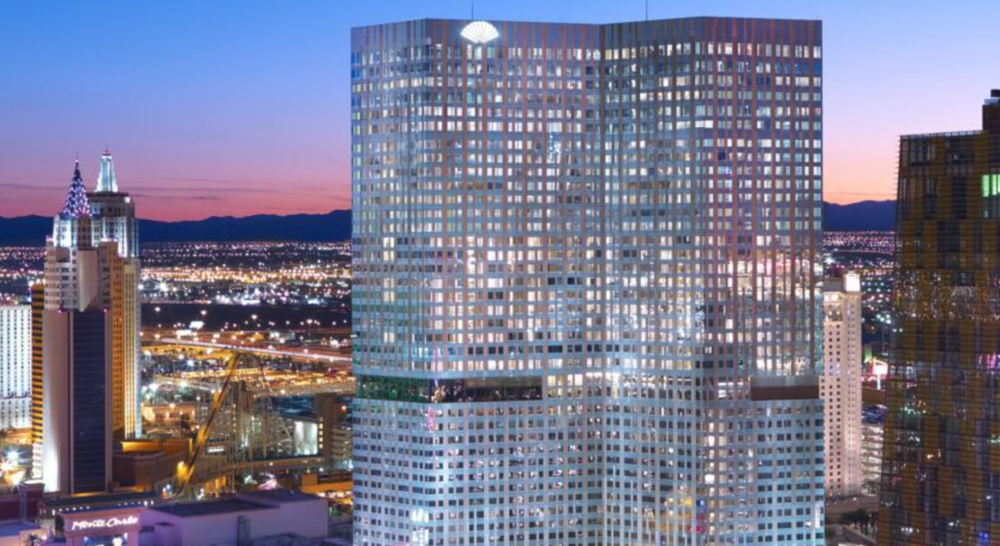
Mandarin Oriental Las Vegas.
3. Cosmopolitan. Admittedly, Cosmopolitan of Vegas is a party resort, but it’s a luxury party resort. You’ll find the luxury in the amenities. All rooms have outdoor patios (huge perk for fresh air or pot maybe), stellar views of the strip (including aerial views of Bellagio fountain), some of the best restaurants in Vegas (Blue Ribbon, Momofuku, Eggslut, Jaleo), a bi-level, swank spa and amazing nightlife (I saw Lady Gaga perform here). Cosmopolitan is my go to when I’m looking for a high-end party vibe.
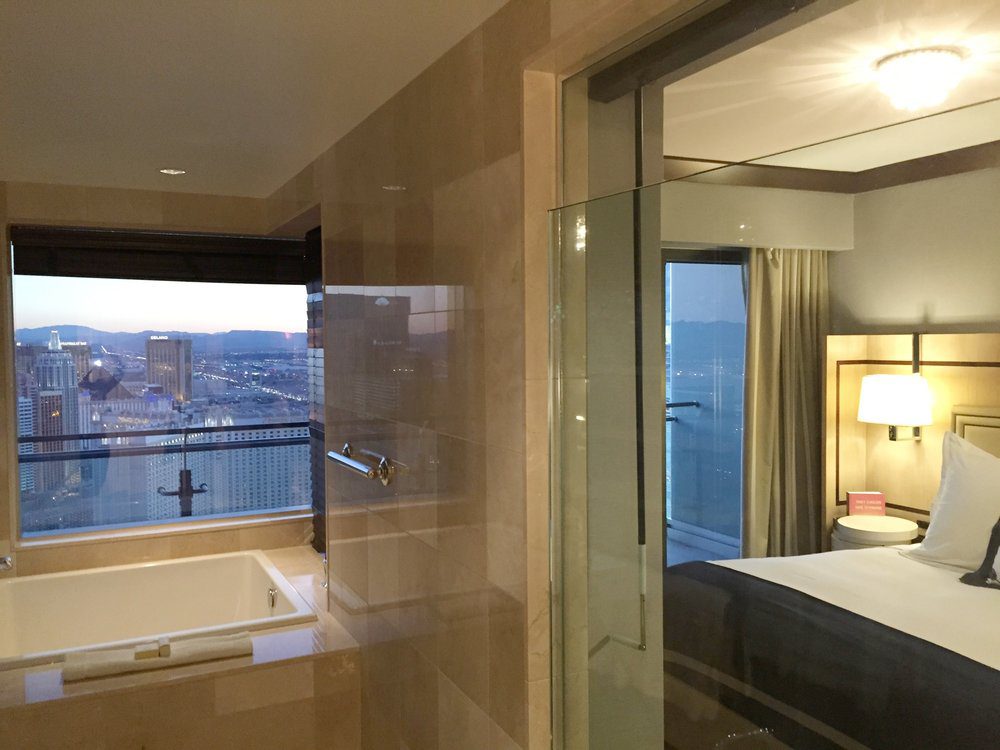
In the Cosmopolitan suites, the jacuzzi tubs also have insane views of the strip.
4. Four Seasons Las Vegas. Four Seasons Las Vegas actually feels like a resort without 2,000 people in it. It’s part of Mandalay Bay but it has its own front entrance and is completely removed from the casino (though extremely accessible). The entrance to the pool oasis is by the elevators (you don’t have to walk a mile or go through two elevators to get here like other resorts), the pool is intimate (not a Vegas mess), there’s a Charlie Parker restaurant, the suites are done well and the service is point on.

Four Seasons Las Vegas.
5. Bellagio. Bellagio is great if you book a suite. Considering how famous the resort is, it can be a total mess and crowded, but I still like staying here. The spa (with its own men/women’s sections) is amazing if you go off peak (when it’s not so crowded) and it’s the only spa with outdoor patios (that overlook the pool). There are three pools but you can pay extra for the pool section with better chairs and service. Also: Le Cirque. Don’t leave without having a dining experience here. One of the best on the strip.

Bellagio’s famous Conservatory.

New Orleans is one of my favorite cities in America, and if you happened to fly American Airlines last month, you probably saw my 9-page spread on the city. Among highlights like food, culture and history, I love the hotels in NOLA, and I’m excited to check into Windsor Court.

JetSetRuby obviously loves Windsor Court.
Windsor Court has been around for decades, but it just pumped $15 million into renovations. Rooms received a facelift (just so you know, it’s so fancy here, 80 percent of rooms are suites, and they have balconies, a rarity in the city) and the outdoor pool deck now has a bar! The spa is one of my favorites in the city (therapists actually know what myofascial is!), and the club lounge on the 22nd floor has awesome views of the river. I’m so happy to be back!
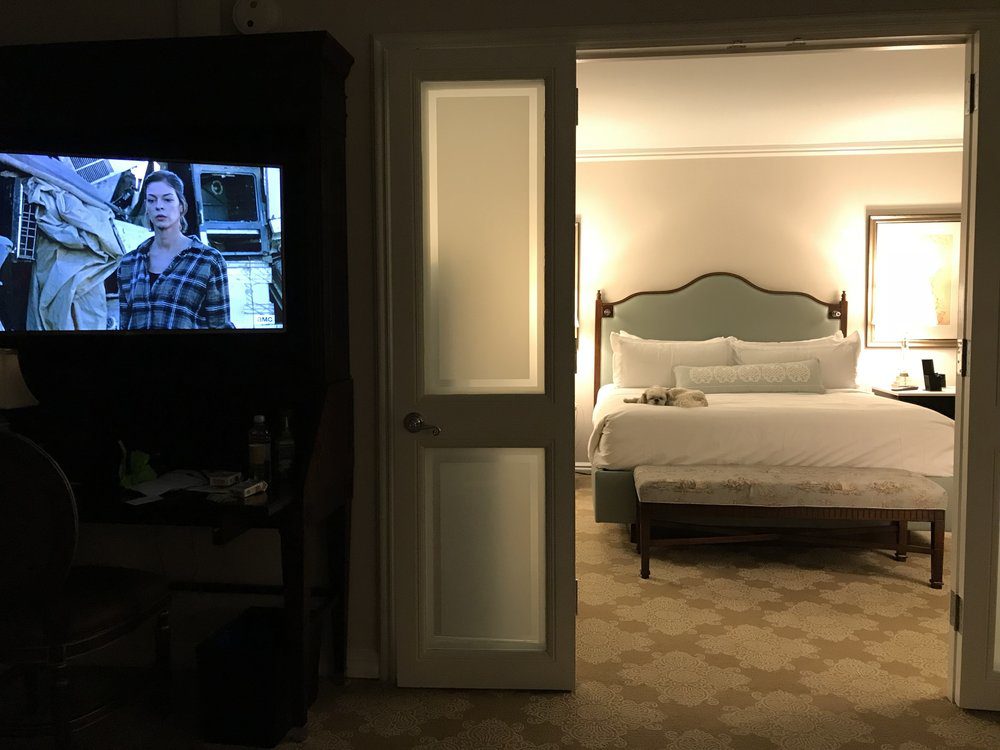
Love Windsor Court.
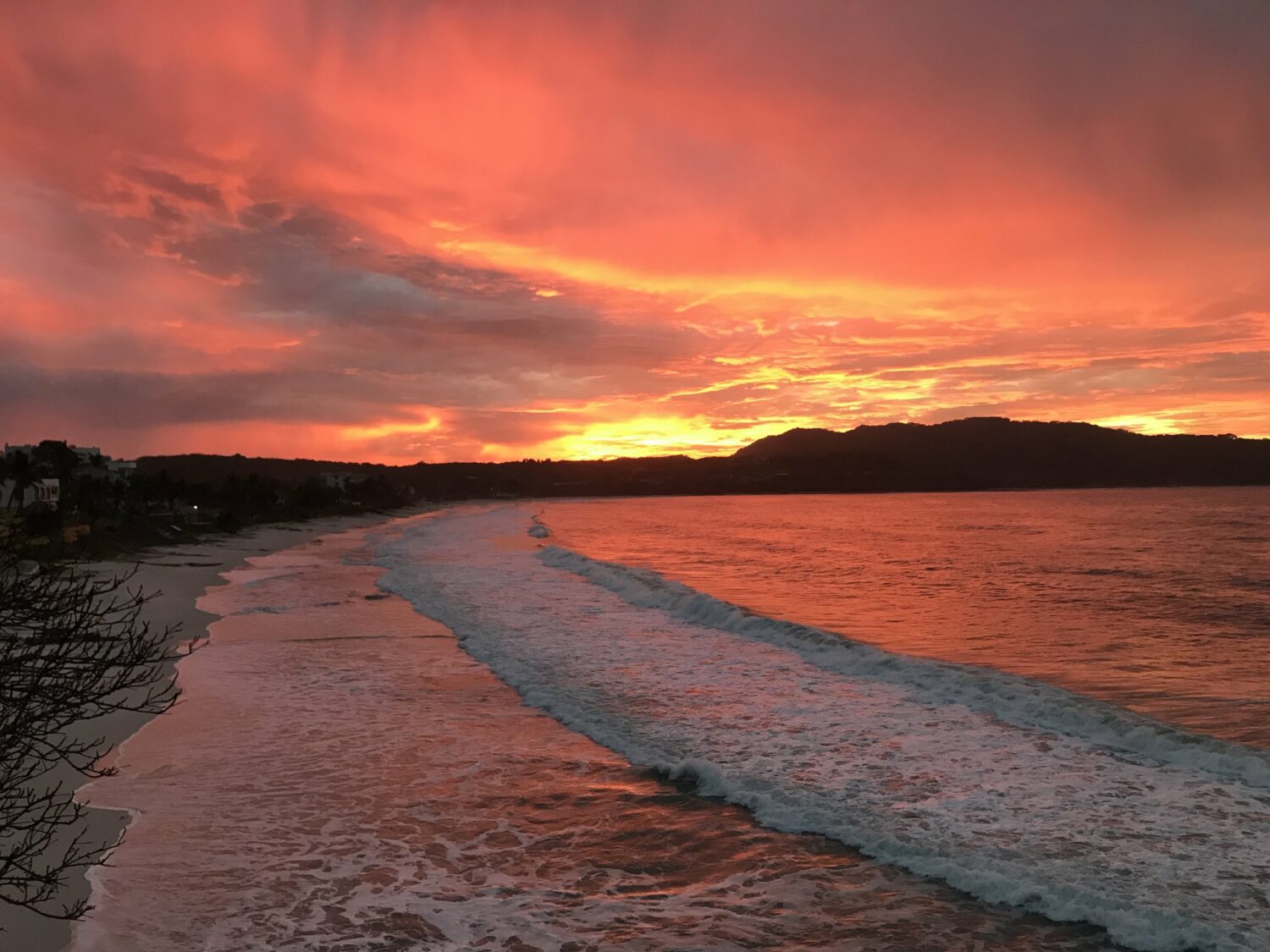
Last month was insane. I can’t even begin to tell you about the significant life changes that set me back posting stories (everything from credit card fraud/identity theft to moving out of my apartment and leaving New Orleans). I had to take a much needed break… but I’m excited to be back and will continue posting informative and entertaining travel stories. Thanks! Jimmy


There’s nothing more awkward than someone asking you to change seats on a plane. I should know. Out of the hundreds of flights I’ve taken, I’ve been in this situation dozens of times, and it never gets better.
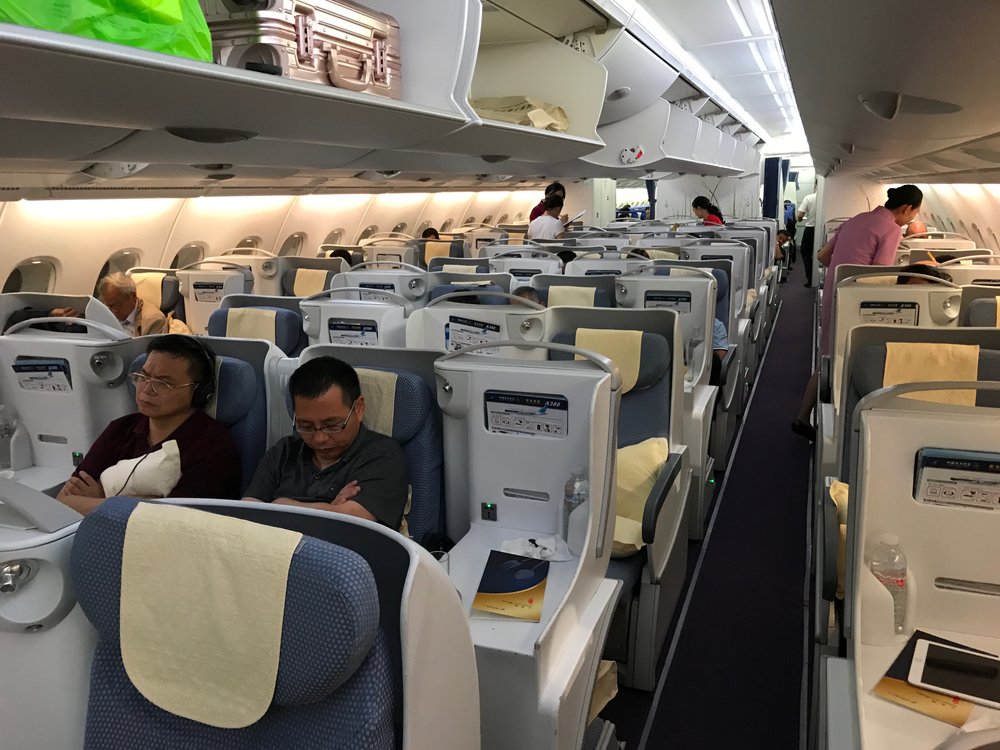
These dudes were like “we are NOT switching even if we have the worst seats in history.”
In general, a passenger will ask you to switch seats so they can literally sit next to their wife, girlfriend, husband, BFF, colleague, whatever. It seems harmless… but doesn’t it give you a little anxiety? You’re put on the spot, having to think quickly for a response, and you want to say no but you don’t want to come across as evil, so you end up saying yes to avoid coming across as evil—and your new seat seems like the devil’s throne. Weird, right? Because you did something nice?
Here’s the thing. You chose your seat weeks before the flight. You should be comfortable in that seat and you don’t have to feel guilty giving it up. It’s YOUR seat! You don’t need to compromise your comfort for someone else. You don’t need to move your bag in the overhead bin, sacrifice your good seat for their mediocre seat or deal with any pressure to say yes, whatsoever. In fact, I find it a little irresponsible for someone to ask you to leave your comfort zone and switch with them. Here’s why.
The couple asking you to switch seats failed to book seats together. That’s on them, not you. There is a 99.9 percent chance the airline did not separate them, so it’s their thing to deal with, not yours. Another reason they could be asking you to switch seats is that they flew standby and got the last few seats remaining. They should be grateful they got seats, and not put anyone in an uncomfortable position to ask to switch. Lastly, if you’re flying first class, a pair of passengers could have been upgraded to the last two seats remaining, so they should be grateful they got the upgrade and just take the seats given to them. Flying is not fun. In fact, it’s stressful. When someone asks to switch seats, I think it’s uncouth, lacking grace and wrong. Why should you now have the responsibility to make a decision, with the potential to feel guilt if you say no? It also looks bad on the person asking. Everyone looks at them with that eye roll.
My recent scenario with a seat switcher: A man asked me to switch seats with his wife so he could sit with her. He was basically begging, and this already made him look ridiculous, mostly because the flight was less than 3 hours. I looked at him with the face of “You spend every waking minute with this woman… you can’t sit apart for three hours?” Eventually, I did switch only to be kind, but it meant I got the bulkhead (with that awkward TV monitor coming out of the arm rest), next to a woman who kept farting and the food cart started from the back of first class, so I did not get my choice of dinner. Sure, whatever, I made this couple happy for three hours, but I thought maybe I’d be rewarded with karma points at the least. Nope. I got farting woman.
I’ve gotten in the habit of saying no to passengers who like to seat switch. This is because I know the plane I’m going to fly in advance, I know the seat I want, I reserve the seat I want and I don’t want any changes. If someone asks me to switch seats, I say “Unfortunately not this time, maybe you can ask someone else.” Nobody is hurt in this situation. I am assertive and get the point across I will not switch seats, and they understand and ask the next person (and yes, they will ask everyone in that cabin to figure out a way to sit with whomever they’re trying to).
I’ve seen parents sit aisles away from their kids, and they were fine. It’s weird to me that two friends or lovers can’t take a short flight away without sitting next to each other, and I think it causes inconvenience and little disruption when they put you on the spot. OBVIOUSLY there are exceptions (like sitting next to your friend who has panic attacks or an old grandma) but the airline will sort this out beforehand with assigned seats, so the chances of you being in the situation of switching in these scenarios are basically zero.
Anyway, if someone asks you to switch seats, get in the habit of saying no, because this faux pas needs to stop. If you’re a super kind person who does not care where he/she sits, just remember: the woman next to you will fart.

One place you don’t have to worry about seat switchers: a private jet!
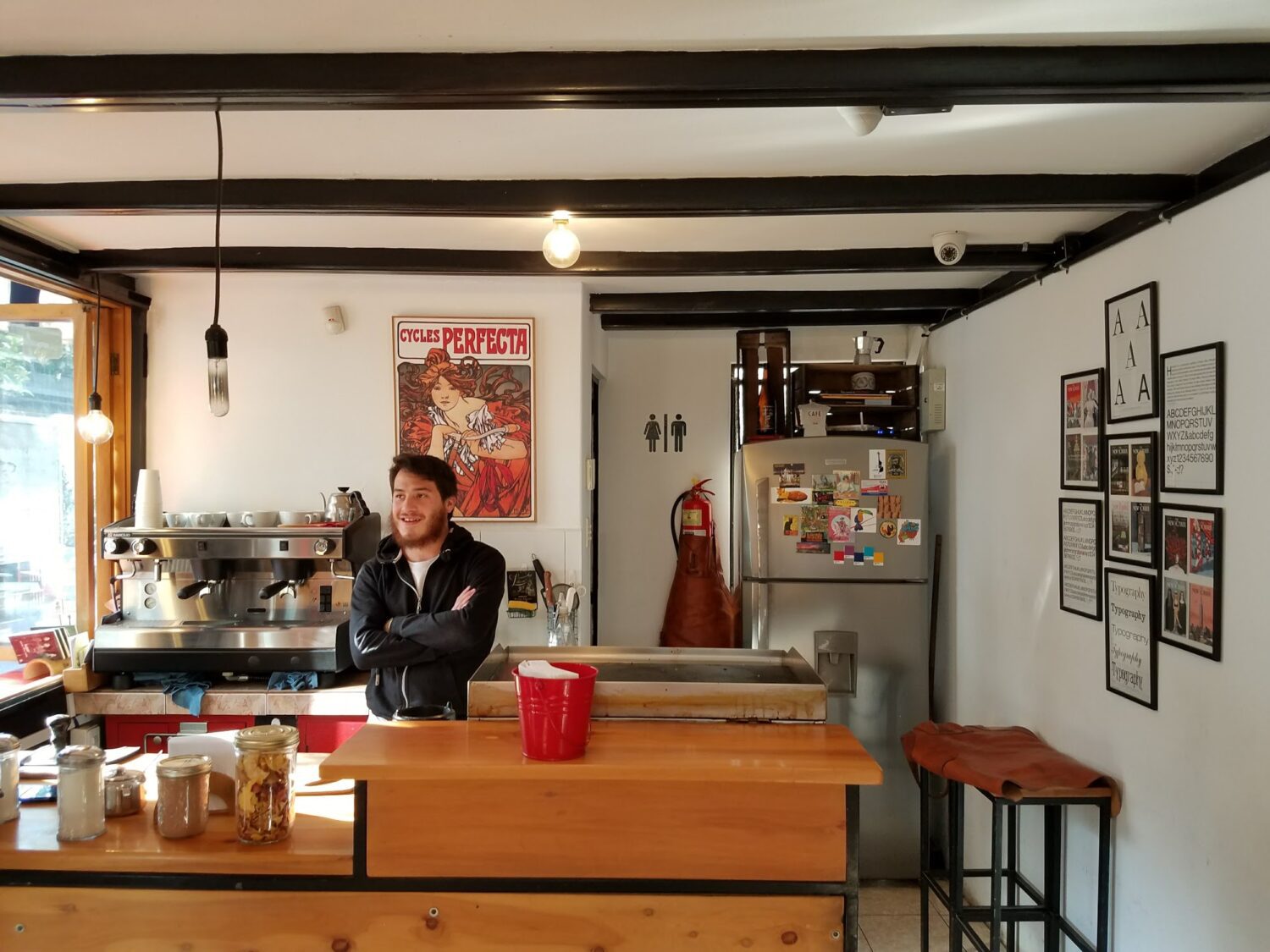

Do you tip this bellman?
Listen. I tip, and I tip well. Like you, I tip valet, bellmen, housekeeping, waiters, bartenders, masseuses, my hairdresser, the pet groomer, room service, tour guides, taxi drivers, butlers, casino dealers, drag queens, delivery boys…. the list goes on—but I’ve noticed that list keeps getting longer in America. I’ll go into a fast-casual restaurant where the employee believes he gets a tip for literally ringing up my order. I walk down the street in a new city where a street performer will chase me down if I took a picture. You can now tip Uber drivers, dog walkers, tarot card readers. Tablets have that tip line when you go to, like, a burrito place or a pet store (and, while not a tip, you can leave a donation at drug stores when you’re checking out, which has similar vibes).
Everyone seems to be asking for money these days, and some times that tip situation can be uncomfortable. We’ve all been there. We don’t want to seem cheap and ungrateful if we don’t leave a tip but, if we don’t leave a tip, we seem cheap and ungrateful. On a vacation, you can end up spending up to $100 a day in tips alone (provided you dine out, Uber, have a cocktail, get room service, have a massage, etc). Some times it can be overwhelming, but it’s inevitable. In fact, tipping has been around since the 1700s, first documented in the UK (“TIP” is an acronym, meaning “To Insure Promptitude,” where servicemen would hope for a bonus for services rendered.).
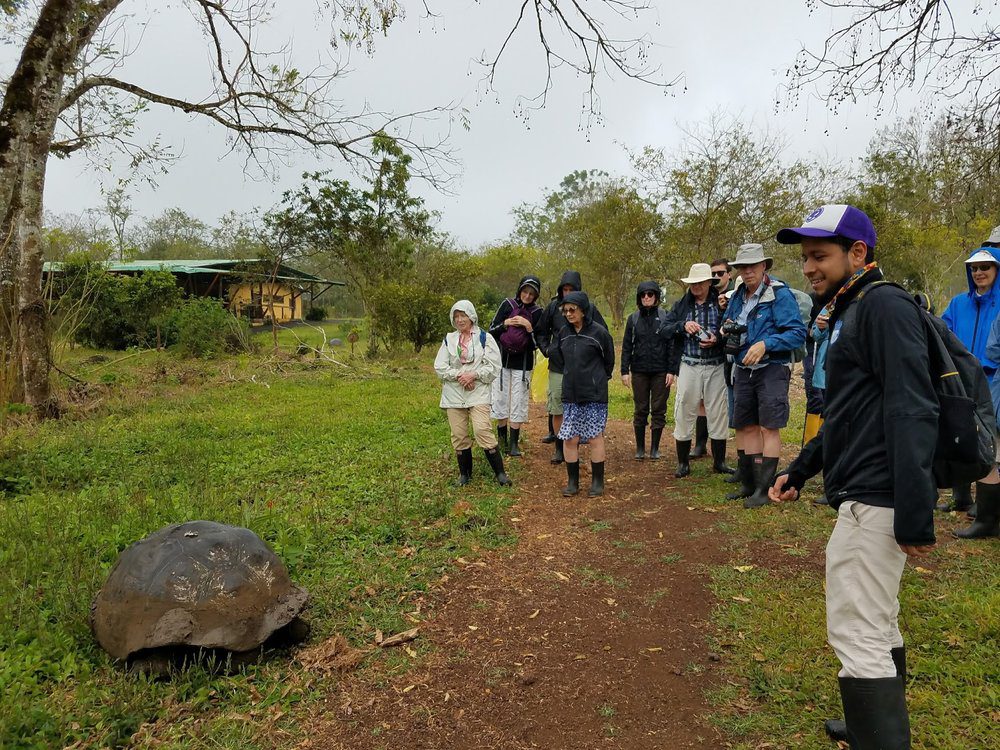
Will you tip this tour guide?
But while tipping has been popping up in nontraditional, unassuming places, it has always been part of the service industry, and the service industry is the backbone of travel. It’s part of the package.
I never questioned this until my friend and I were discussing it last night, where it was pointed out tipping is “optional” yet feels mandatory when you travel. And while tipping has traditionally been linked with service, it’s now expected with actual performance. You can’t walk down a street in New Orleans without someone banging on drums, writing poetry from a typewriter, doing a juggling act or painting themselves in gold, expecting a tip if you engage with them. It’s not just here, but anywhere there’s a dense concentration of tourists in any part of the world. Travelers often feel that tip pressure without any interaction but, no matter what the service or performance is, it’s still linked with travel and tourism to a degree. No one should make you feel pressured to tip and certainly not guilty if you don’t, but tipping is part of the travel DNA. While “optional,” it is an expectation and assumed. That’s just how it’s been for centuries.
While I can’t tell you to tip the deli guy for ringing you up, I can tell you that tipping a valet or housekeeper is part of their salary. It’s easy to identify the people you tip in travel because it almost includes everyone who offers a service or performance. So, budget in tips when you plan a vacation. Not only does this make you feel better (and not guilty when faced with the situation), it only helps the travel industry continue to thrive.

Tip the cafe dude?
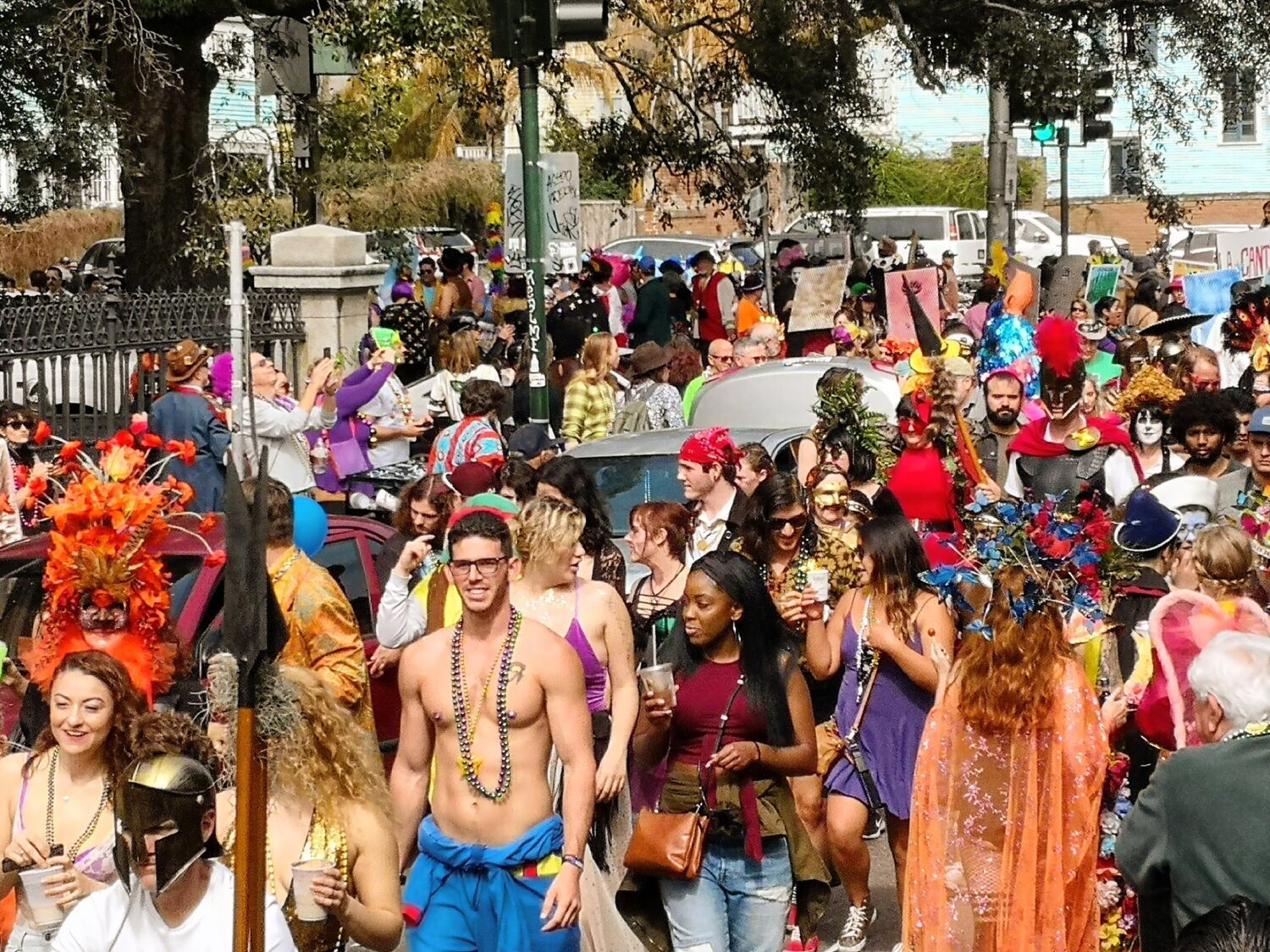
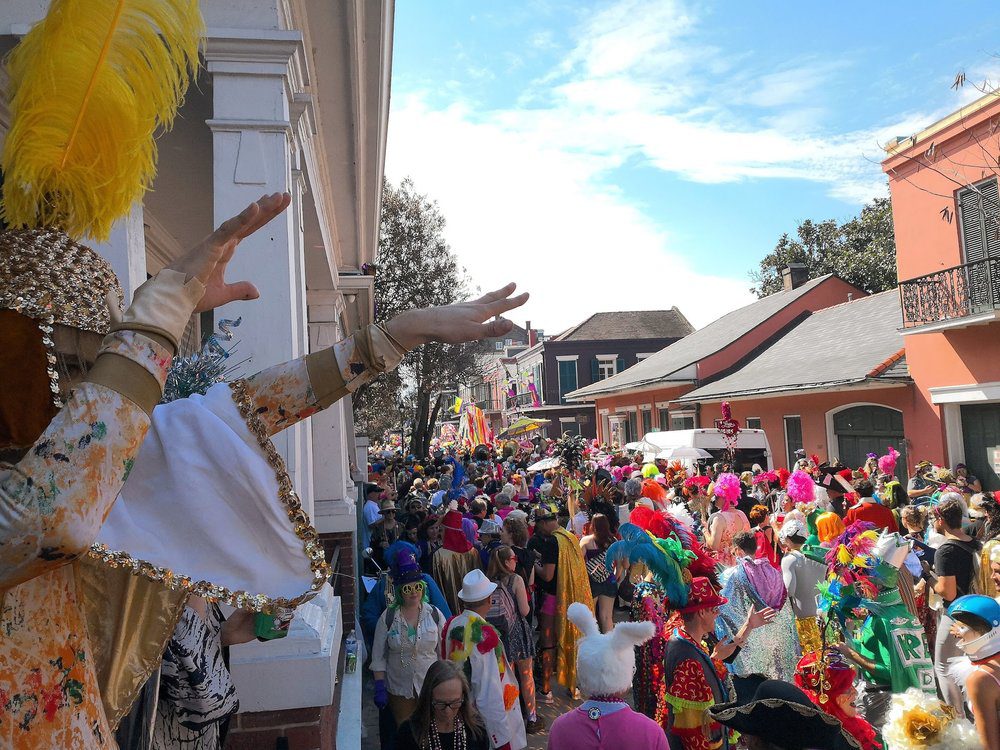
New Orleans Mardi Gras on Royal Street.
One of my favorite cities in the world, New Orleans, Louisiana is celebrating its tricentennial this year. Not only is it one of the oldest cities in America (300 years), it’s one of the most culturally rich and historically fascinating cities of all time.
To help celebrate New Orleans’ tricentennial, and rather than give an odd list of what to expect this year, I went through the city’s complicated yet exciting history, highlighting a significant event every decade that helped shape the city today.

Party time in New Orleans!
Obviously, this was one of my most research intensive assignments. If you happen to fly American Airlines this month, please pick up a copy of the in-flight magazine, where you’ll see my beautiful 9-page spread! You can also click the link here or see below.
If you’re visiting Crescent City, don’t forget to do these 4 amazing, mandatory things for the perfect NOLA experience, check out these awesome new hotel bars and, of course, hipster TF out (because it’s cool now!).
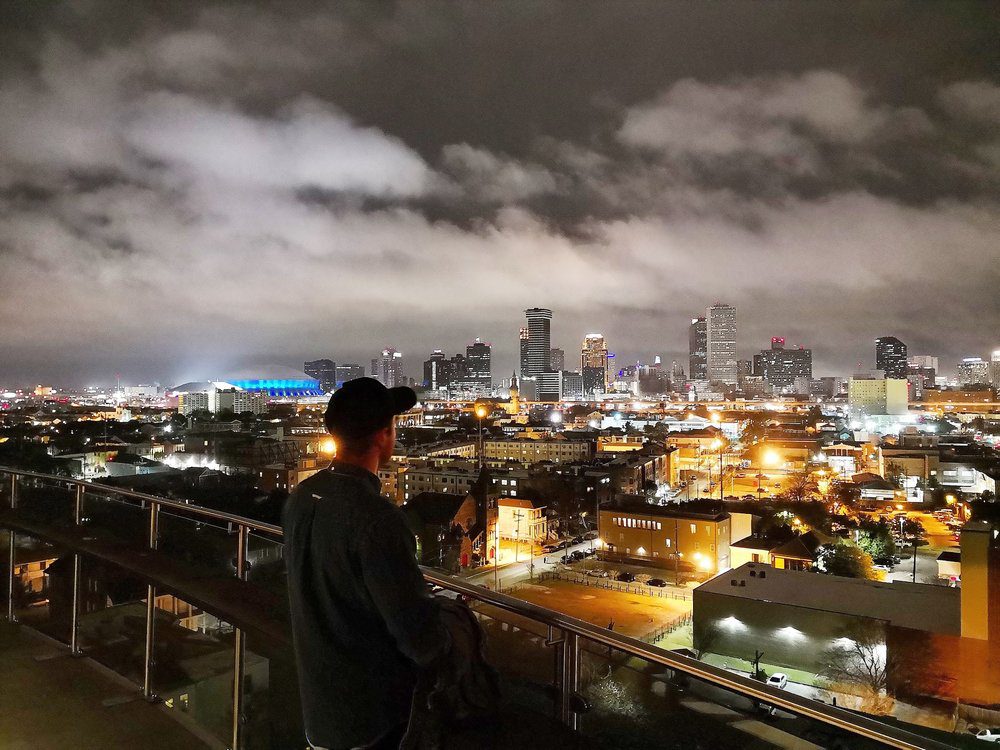
New Orleans by night (from Pontchartrain Hotel).
New Orleans Turns 300!
Over the last three centuries, New Orleans has survived hurricanes and fires. It has been coveted, ruled and swapped by various empires, and enriched by waves of immigrants, cultures and cuisines, not to mention millions of wild Mardi Gras revelers. To celebrate the city’s 300th birthday this year, we take a look back at 30 decades that made the Big Easy one of America’s most storied cities.
1710s
BREAKING GROUND
The French saw an elevated bank along the Mississippi River as an ideal location for a colonial city—it was drier than the surrounding bayou, near Native American trading shortcuts to the Gulf of Mexico and was a safe distance from Spanish and English rivals. In 1718, Jean-Baptiste le Moyne de Bienville, governor of French Louisiana, named the site Nouvelle Orleans in honor of the Regent of France, Philippe II, duc d’ Orléans, nephew of Louis XIV.
1720s
PIRATES AND BOOZE
Though Bourbon Street seems aptly named today, it was not named for the American whiskey, but rather for the Royal House of Bourbon, a ruling family in France, in 1721. That said, alcohol has played a leading role in the story of this colorful, sometimes wild street.
Lafitte’s Blacksmith Shop is not only one of the oldest buildings in the French Quarter, built in 1722 and 1732, but also the oldest structure used as a bar in the U.S. Fifty years after it was built, Jean and Pierre Lafitte used it as a base for a smuggling operation. This local haunt for refugees and pirates evolved into a place for sailors and hustlers, and it once served as a gay bar (Tennessee Williams was a customer). Now, it’s one of the most popular watering holes in town, with patrons spilling into the street on the weekends.
1730s
GETTING FAT
A Christian holiday with roots in pagan spring fertility rituals, Mardi Gras (or “Fat Tuesday”) spread from Rome to the rest of Europe in the 17th and 18th centuries, eventually reaching the New World. Historians believe the first American Mardi Gras took place in 1699 in rural Louisiana, coming to New Orleans in the 1730s—initially without parades, floats or beads. It has since grown into the rowdiest and most famous Mardi Gras event in America.
1740s
IT’S MY PARTY
In 1743, Louisiana governor the Marquis de Vaudreuil established elegant society balls restricted to the elite. These private, opulent affairs are today officiated by a handful of secret societies, known as “krewes.” Only five of these exclusive societies existed until the 1900s, but now there are more than 50 “krewes” celebrating a spectrum of themes and cultures with balls and parade floats—though it’s near impossible to be invited into one of the original societies that still exist today.
1750s
SISTER ACT
In 1752, nuns from Normandy arrived in New Orleans and established the Old Ursuline Convent, also a hospital and shelter for young girls. Today, it’s a museum filled with centuries-old scriptures, records and drawings, and stands as the oldest French Colonial building in the Mississippi Valley.
1760s
THE SPANISH REQUISITION
The long, expensive and confusingly named French and Indian War, pitting the French against the English, prompted France to sign the secret Treaty of Fontainebleau in 1762. The agreement ceded New Orleans to Spain to keep it out of British hands. Though some French and German settlers rallied against Spain in the Rebellion of 1768, the country regained full control in 1769 with the institution of Spanish law.
1770s
REBEL REBEL
During the American Revolutionary War, Spanish-controlled New Orleans smuggled aid up the Mississippi to the 13 rebel colonies. In 1779, Louisiana governor Bernardo de Gálvez y Madrid overpowered the Brits in the Battle of Lake Pontchartrain, earning an invite from George Washington to attend the 1783 Fourth of July parade. Today, a statue of Galvez stands on Canal Street.
1780s
HOT SOURCE
On March 21, a candle in a Chartres Street residence sparked one of New Orleans’ worst disasters, the Great Fire of 1788. As the blaze spread, priests refused to ring church bells in alarm, as it was Good Friday. The fire ultimately destroyed 856 of the city’s 1,100 buildings—which led to a Spanish-style reconstruction that produced the beautiful French Quarter. Original buildings that survived the fire, such as the Ursuline Convent and Lafitte’s, contribute to the eclectic architectural mix.
1790s
HIGH SPIRITS
In 1794, an all-boys boarding school and orphanage burned down on Royal Street, killing five children. The Andrew Jackson Hotel, built on the very spot, is today popular with both tourists and spirits. There have been countless alleged sightings of bygone boys playing in the courtyard and guestrooms, as well as child laughter in the dead of night. “Armond” is said to be the most active spirit.
1800s
FRENCH TOAST
With the signing of the Third Treaty of San Ildefonso in 1800, Spain handed the colonial territory of Louisiana back to France. The treaty was handled under the radar to avoid provoking an American or British response before French troops could defend the city. Three years later, Napoleon sold the Louisiana territory to the U.S. for $15 million (around $316 million today). The 828,000-square-mile Louisiana Purchase doubled the size of the U.S.
1810s
PITCHFORK BATTLES
In 1811, Charles Deslondes of Haiti led one of the largest slave insurgencies in U.S. history. An estimated 200 to 500 slaves armed themselves with farm tools and marched 22 miles in two days toward New Orleans, burning plantations and crops and chanting “Freedom or Death” along the way. Their goal, according to historians, was to spread the rebellion to the city and establish a black state on the river. The rebellion was brutally quashed.
1820s
ROCK & ROULEZ
In the winter of 1827, after attending a Mardi Gras parade in Paris, a young Louisianian rallied his friends in New Orleans and led a spirited street procession. As the tradition evolved over the years, revelers donned masks, rode on carriages and horseback, dressed in colorful costumes and generally kicked up their heels. The march would eventually become the New Orleans Mardi Gras street parade, the city’s largest and most raucous celebration.
1830s
FINER THINGS
The Garden District, with its large, lavishly decorative mansions and lush green spaces, rapidly developed. In 1833, in the center of it all, the city established the famed Lafayette Cemetery, with above-ground tombs. Imbibing took an upturn, too, as Haitian immigrant pharmacist Antoine Peychaud created America’s first cocktail, the Sazerac, in 1838, by mixing his family’s bitters with Cognac for customers. Later recipes swapped Cognac for American rye.
1840s
HOSPITALITY HISTORY
In 1840, Antoine’s, NOLA’s oldest fine-dining restaurant—famous today for high-end French-Creole cuisine—opened as a bed and breakfast run by Antoine Alciatore and his wife. In 1868, the family moved it to St. Louis Street, where it stands today.
1850s
KREWES CONTROL
After decades of hidden ceremony, in 1857 the Mistick Krewe of Comus became the first secret society to host a public Mardi Gras parade, flaunting its king and queen on an elaborately decorated float. Other krewes followed suit and a new tradition was born, leading to the formation of a slew of additional organizations.
1860s
GIVE ME SOME SUGAR
Originally opened as a humble coffee stand across from Jackson Square in 1862, the still-beloved Café du Monde gained popularity with its beignets. The pastry evolved from Spanish sopapillas, getting a dusting of powdered sugar, as cane was abundant along the Mississippi River.
1870s
SPELLBOUND
Voodoo (or vodou) took root in New Orleans in the 1700s via the slave trade. Over the years, voodoo queens became powerful local figures. In 1874, Marie Laveau II, the most influential, held a public rally at Lake Pontchartrain, attracting 12,000 New Orleanians, both white and black. The event is still talked about today.
1880s
GUMBO JETS
Abby Fisher, a professional chef, began her rise to prominence, eventually becoming one of the first African Americans to publish a cookbook, What Mrs. Fisher Knows about Old Southern Cooking. Among her recipes are ochre gumbo and jumberlie (jambalaya), which put New Orleans Cajun and Creole dishes on dinner tables across America.
1890s
JAZZ HAPPENS
In the late 1800s, brass bands and ragtime piano were popular, while poor NOLA neighborhoods added a West African/Caribbean touch to local music. From this mix emerged Charles “Buddy” Bolden, a cornetist who formed a group in 1895, fusing these influences with blues, black Baptist music and his own legendary improvisations—in effect, inventing jazz. Sadly, Bolden entered a downward spiral, culminating in his admittance to a mental institution at age 30, where he lived until his death in 1931.
1900s
THE BIG EAT-Y
Sicilian immigrant Salvatore Lupo, founder of Italian-American grocery store Central Grocery, created a special sandwich in 1906 for Sicilian workers in the French Market who missed homemade Italian grub. He piled the submarine-style sandwich with salami, ham, mortadella, provolone, marinated olive salad and a secret sauce. So began the famously calorific muffuletta sandwich—still a favorite among the Big Easy’s big eaters.
1910s
PUMPED UP
Surrounded by bayous, Lake Pontchartrain and the Mississippi River, New Orleans often suffered from flooding and attendant diseases, such as yellow fever and malaria. In 1913, engineer Albert Baldwin Wood invented the 12-foot screw pump to push floodwater over levees into Lake Pontchartrain. The American Society of Mechanical Engineers declared the system a Historical Mechanical Engineering Landmark in 1974.
1920s
HIGH TIMES
New Orleans thrived in the 1920s—jazz flourished and cool streetcars shuttled people around. Affluent visitors in particular had a ball. The Orpheum Theater opened in 1921, and the Roosevelt Hotel was redesigned and renamed in honor of President Roosevelt in 1923. There was a boom of hotels with ballrooms (including LaSalle Hotel, The Hotel New Orleans and The Jung Hotel), along with high-end dining (Commander’s Palace, Antoine’s, Galatoire’s and Arnaud’s).
1930s
GOOD SAVE
The state amended its constitution in 1936, empowering the Vieux Carré Commission to preserve the French Quarter, making it the nation’s second legally protected major historic district (after Charleston, South Carolina). The effort paved the way for future tourism and, of course, allowed locals to keep their loveliest neighborhood.
In 1938, Tennessee Williams moved to New Orleans, where he wrote the play A Streetcar Named Desire, set in the French Quarter.
1940s
CART BLANCHE
As tourism took off, locals Clem and Violet Lauga had the brilliant idea of offering carriage rides through the French Quarter. They bought a horse and cart from Aunt Sally’s Pralines and started selling rides in 1941. The carriages, now using mules, are a popular way to explore the Quarter.
1950s
ITALIAN JOBS
Sicily roiled with political turmoil after World War II. Many citizens fled to the U.S., where Italians had been immigrating since the late 1880s. A burgeoning New Orleans, in need of unskilled labor, welcomed them in droves.
1960s
WHO DAT?
Inside the Bayou Bar, the Pontchartrain Hotel’s divey pub, the New Orleans Saints officially signed into the NFL in 1966. The bar’s football legacy continues today, as Cooper Manning (son of former Saints quarterback Archie, brother to Peyton and Eli) reopened this sacred Saints space in 2016. You can order Mile High Pie (layered vanilla, chocolate and peppermint ice cream), just as fans did in the ’60s.
1970s
A SERIES OF FORTUNATE EVENTS
In 1970, the first New Orleans Jazz & Heritage Festival debuted as a relatively small-scale soiree in Louis Armstrong Park, attracting a mere 350 attendees. (It’s said there were more people on stage than in the audience.) The festival has since become one of the city’s major annual events, attracting half-a-million-strong crowds and musical acts like Mumford & Sons, Harry Connick, Jr., Stevie Wonder and Usher. Tickets in 1970 cost $3. Today, they’re $80.
In 1972, meanwhile, Southern Decadence kicked off as a gay house party where guests dressed as their favorite “Southern Decadent.” Today, the Labor Day shindig attracts more than 210,000 participants.
1980s
DRIVING AMBITIONS
These days, the French Quarter Festival pulls crowds of 750,000-plus for four days of live music, food and partying, but the event had fairly inauspicious beginnings. The inaugural fest, in 1984, was held to celebrate the completion of 14 weeks of annoying road construction. There were breakdancing competitions and, surprisingly, Ed McMahon guest-hosted a battle of the bands. Only a few hundred people attended. Times have changed, and the roads are holding up (mostly).
1990s
BAM!
Culinary celebrity Emeril Lagasse opened his first eatery, Emeril’s Restaurant, in the Warehouse District in 1990, followed by NOLA, Emeril’s Delmonico and Meril. The city saw some literary action, too. Anne Rice’s Interview with the Vampire became a blockbuster movie in the mid ’90s, steering droves of tourists to the Garden District.
2000s
THE STORM
Category 3 Hurricane Katrina hit the city on August 29, 2005, with winds up to 125 mph and a 20-foot storm surge, flooding 80 percent of the city and resulting in 40,000 people being quarantined in the Superdome and the Ernest N. Morial Convention Center for five days. In Louisiana, 1,577 people lost their lives. Relief efforts were monumental, with more than 1 million volunteers flocking to New Orleans to help rebuild the city. NOLA has been on the rebound—there were around 800 restaurants here before Katrina; now there are 1,400.
TODAY
Beyond this year’s tricentennial happenings, NOLA’s historic Spanish Plaza on the riverfront will see a much-anticipated $7-million facelift, and the city is springing for a $37-million state-of-the-art ferry terminal.
BIRTHDAY BOOMS
This year offers myriad ways to celebrate and get to know what makes NOLA NOLA.
-
The Historic New Orleans Collection, a museum and research center that spans 10 historic buildings throughout NOLA, adds a third campus, this one in the French Quarter, inside the 19th-century Seignouret-Brulatour House, opening this fall.
-
“Art of the City,”a retrospective of contemporary art from the 1984 World’s Fair to today, kicks off the opening of the new campus.
-
“New Orleans, the Founding Era,” an exhibition exploring the first few decades of NOLA and its earliest inhabitants, runs until May in the collection’s current main location.
-
Public art installations spike this year, including art star Kara Walker’s Kataswof Karavan, a contemporary sculpture of a steam calliope akin to those used on river steamboats.
-
The Tricentennial Symposium, March 8-11, explores 300 years of NOLA through lectures and cultural programming.
-
Tricentennial Navy Week, April 19-25, sees U.S. Naval vessels and tall ships from around the world dock in town, where the public can tour them all week.
-
Bourbon Street is undergoing a $13 million facelift to amp up security, fix sewer lines and repave the road. It’s the first time Bourbon Street’s infrastructure has been fully reconstructed since 1928.
NOLA SPIRIT
Though Hurricane Katrina was destructive, it also fostered a lasting sense of humanitarianism in New Orleans, as seen with the “Cajun Navy”—Louisianians who headed west with their boats to help out in Texas after last summer’s Hurricane Harvey caused $180 billion in damages.
And then there’s former Saints player Steve Gleason (pictured above) and his ALS support foundation, Team Gleason. After Hurricane Maria decimated Puerto Rico, ALS patient Carmelo Diaz was stranded and in need of medical care. The situation was so dire that Diaz’s wife had to power his ventilator with car batteries to keep him alive. Gleason, who formed Team Gleason after he was diagnosed with ALS in 2011, heard of the situation and contacted a friend at American Airlines for support. The next day, with the help of Donald Silkwood, general manager of American Airlines’ station at Cleveland Hopkins International Airport, Team Gleason made their way to Puerto Rico, escorted him with American Airlines staff to the airport, flew him to New Orleans with his wife and arranged for his treatment at Ochsner ALS Center. Today, Diaz is alive and well, and so is New Orleans’ spirit of camaraderie in the face of tough times.

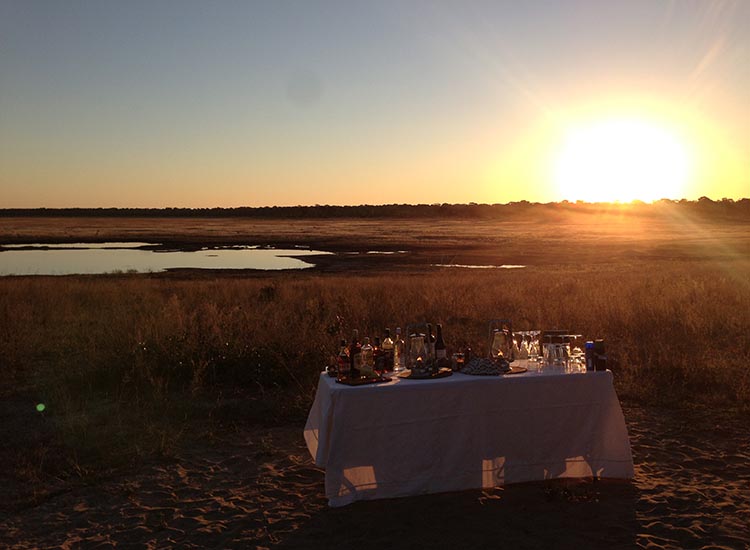
Fly a friend to Africa, maybe?
I’ve said it before and I’ll say it again: frequent flier miles and points lose value every day. The longer they sit in your account, the more they metaphorically start to rust. Some people want to save their air miles for the perfect vacation but it may not even be an option with less routes offered, more miles needed to go and, well… those expiration dates. If you have tons of miles and don’t see yourself flying in the near future, spend it well on these five other things you can get yourself.
1. Gift cards. All major airlines allow you to use your miles to “shop.” Don’t even look at the merchandise as the exchange is terrible and it’s mostly junk you’ll never use/wear. Go straight to the gift cards. Every airline lets you trade in miles for gift cards. The exchange is atrocious (think 25,000 miles for $100 gift card), but if you’re just going to let your miles expire, go nuts here. I’ve used miles to get gift cards at Bloomingdales, Neiman Marcus, Amazon and more.

You can get luxury gift cards with miles.
2. Fly your friend. If you’re not going to fly, why don’t you send your friend down to visit? Or if you got a great deal on a flight, why don’t you use your miles to fly your friend to share that vacation with you? Considering I amass tons of miles a year, I’m grateful to have this option. But trust me; you’ll want to do it soon. I had always wanted to fly my mom to South Korea with all my Delta miles. But, when she finally had time to go this year, first-class tickets were no longer 100,000 miles r/t. They were at least 350,000. GO…. NOW!
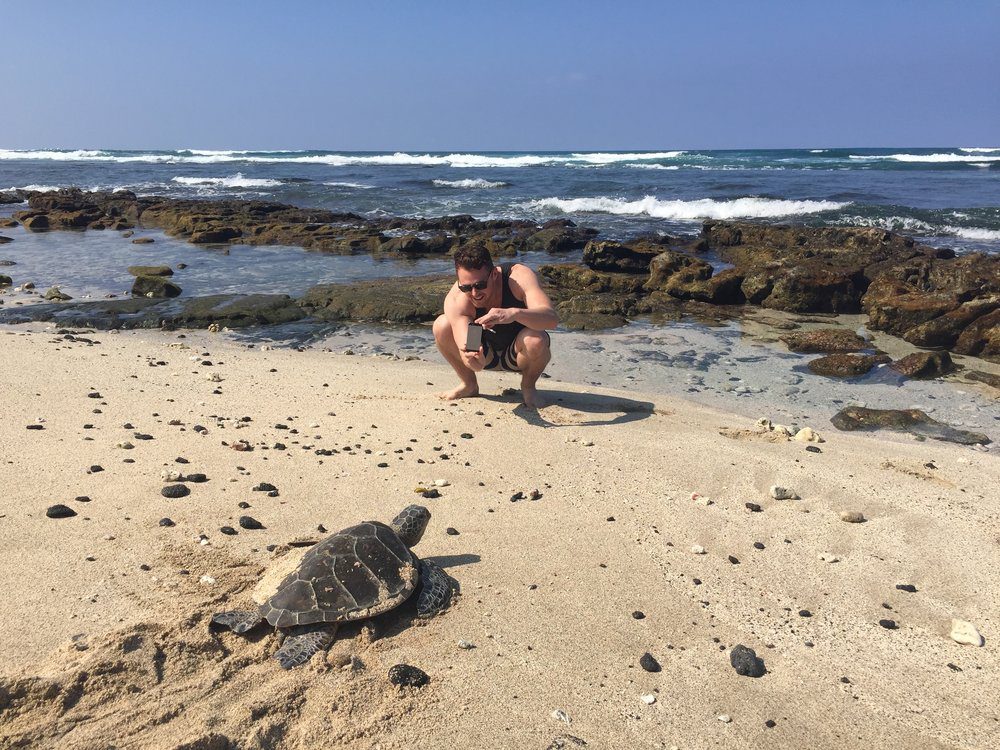
My friend Jason in Hawaii with me, courtesy of air miles.
3. Magazines. If you have a small amount of miles and can’t seem to get anything with them, cash them in for magazines. Every airline has magazines for miles, and they’re as low as 500 miles for a year subscription to basically every major magazine and newspaper.

Magazines for Miles is a thing… and you can get them directly with your airline of choice on their own site, too.

I’m celebrating my BIG 40th in one of my favorite places in the world… Puerto Vallarta! I’m so grateful to be surrounded by 11 friends, most of whom I’ve known for 15 years ????. There’s no better place to celebrate than Villa Mandarinas!!!
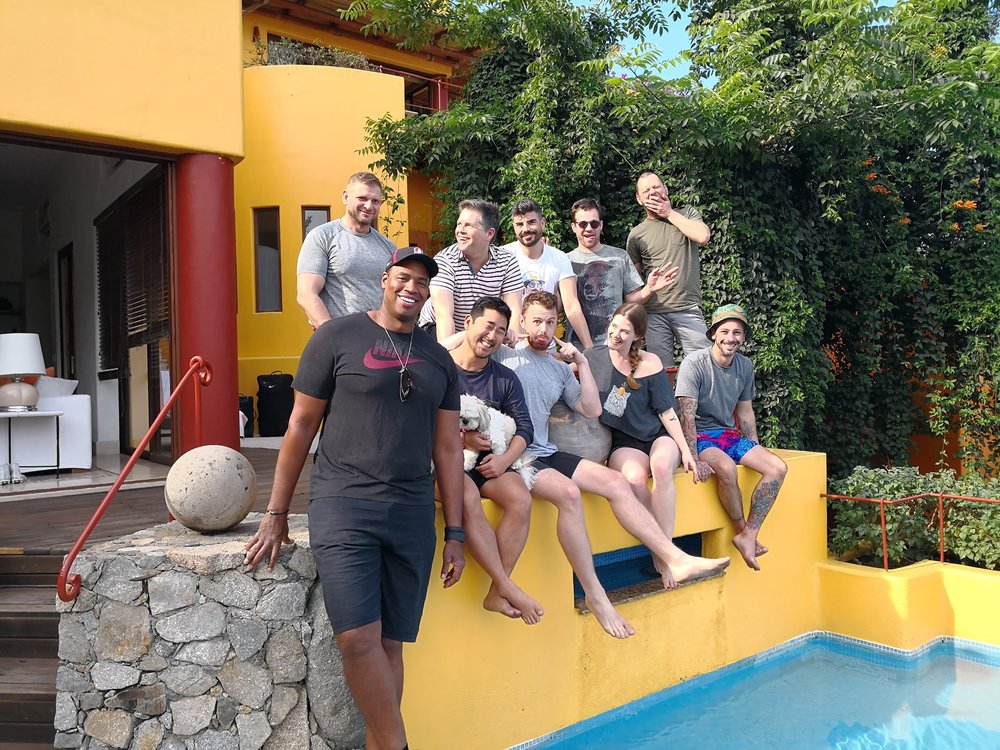
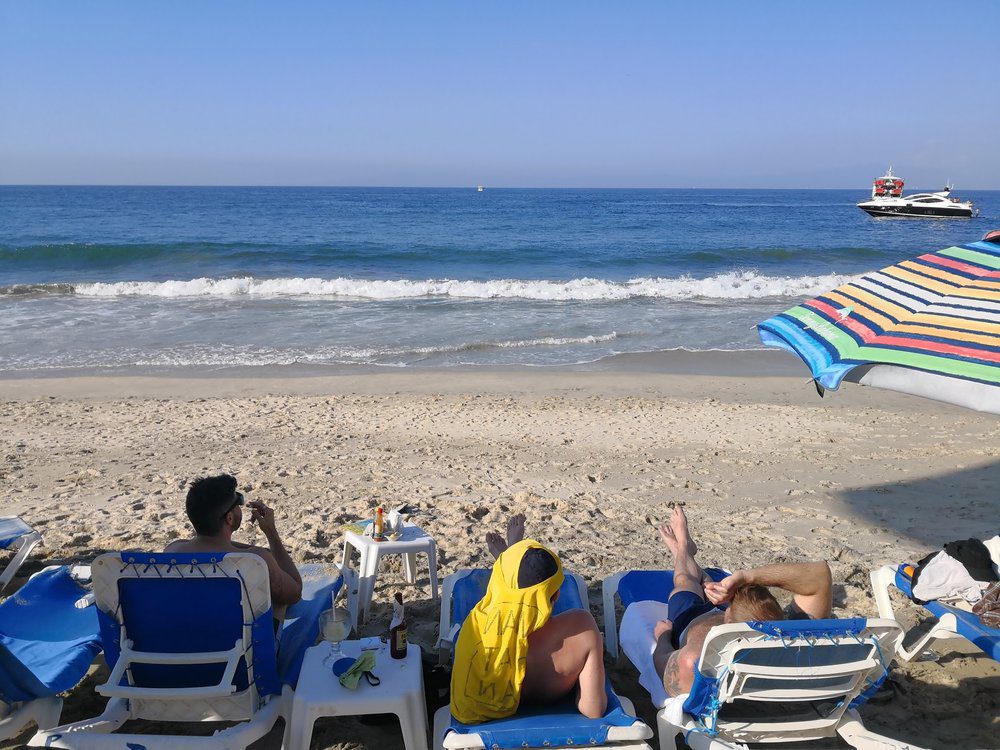


My 40th at Casa De Mita!
Birthday week has officially started, and there’s no better place to kick it off at Casa De Mita. I’ve celebrated my last two birthdays (and one Christmas) here with friends, which should show you how special it is. It’s a luxury, all-inclusive boutique hotel in Punta Mita, a magical sanctuary on its own secluded beach. There’s an outdoor, saltwater pool, gourmet Mexican cuisine, premium liquor and gorgeous rooms that have tons of soul.
Casa De Mita, one of my favorite hotels in Mexico.
There really is no other place I’d rather be! I wrote a Casa De mita review for Telegraph here in case you want more information. It’s seriously an unforgettable place.
Sunset at Casa De Mita in Punta Mita.
